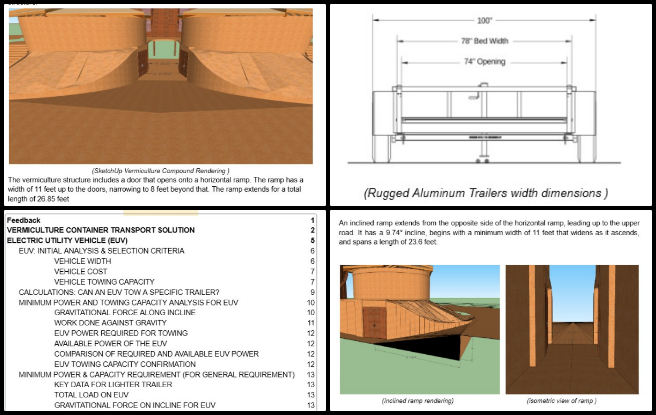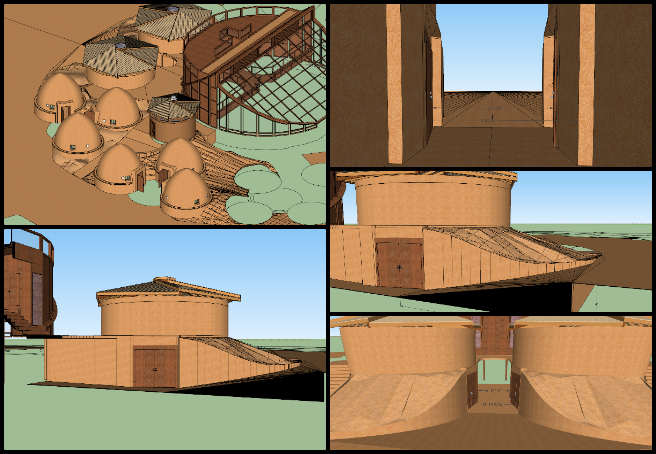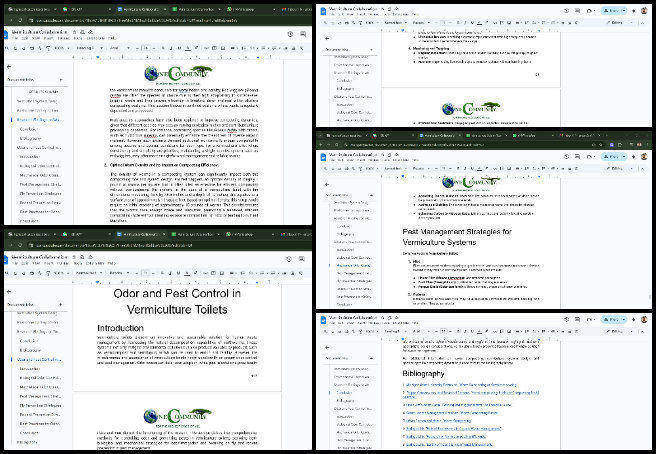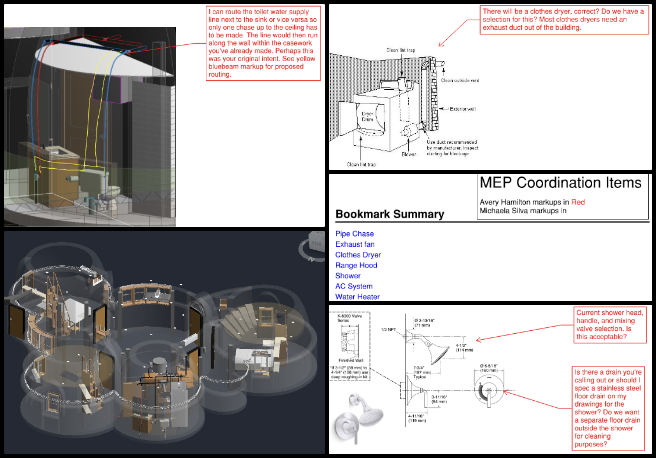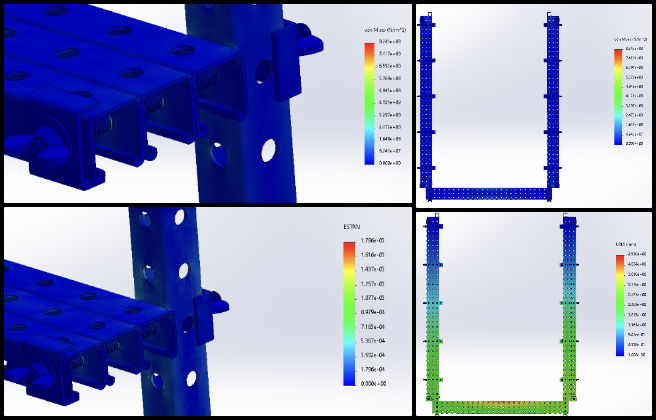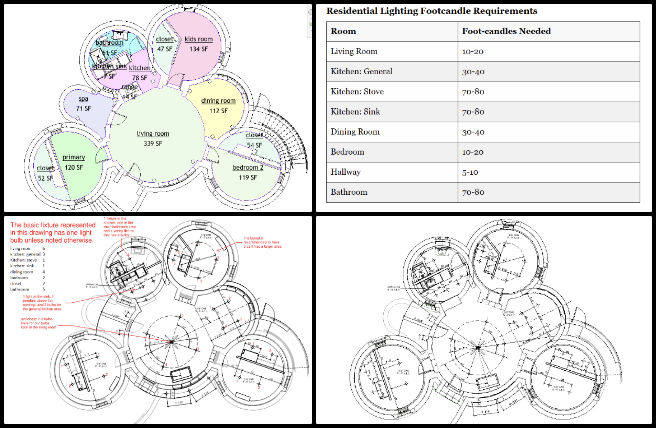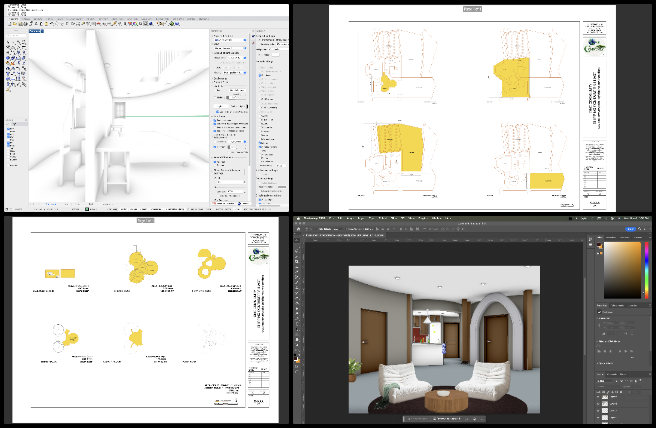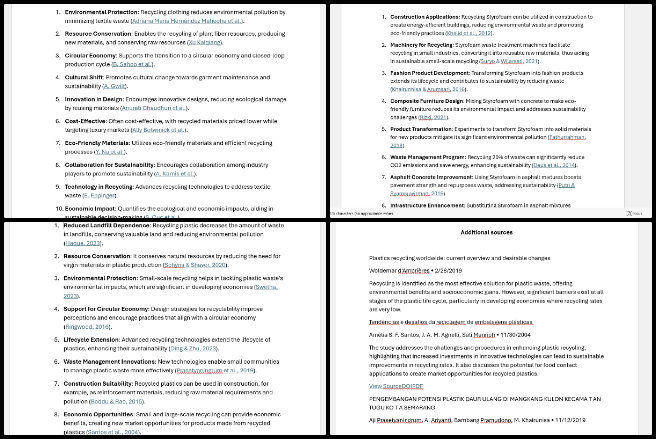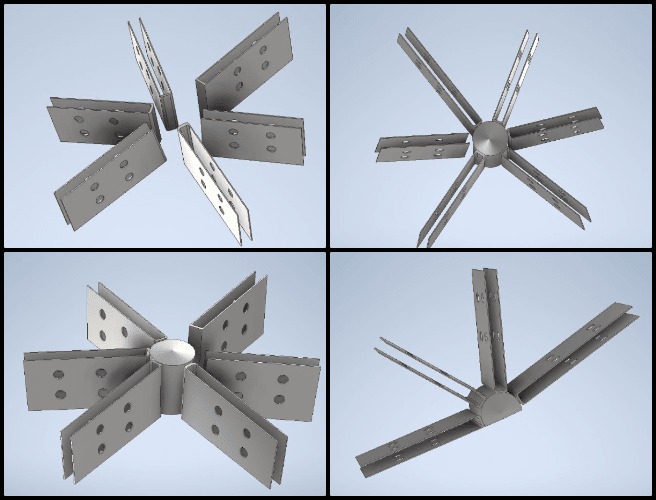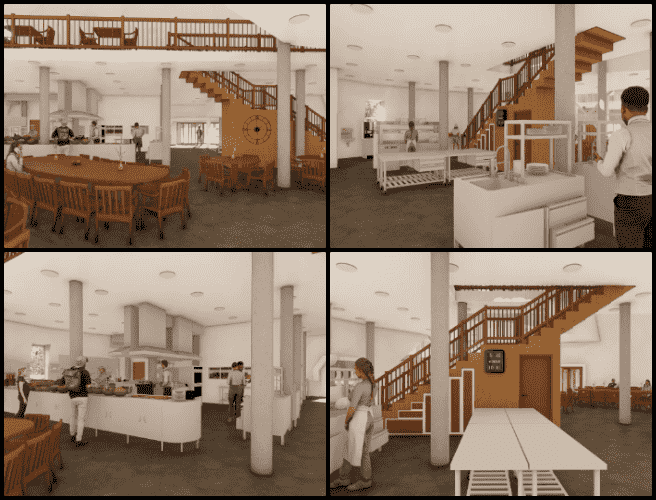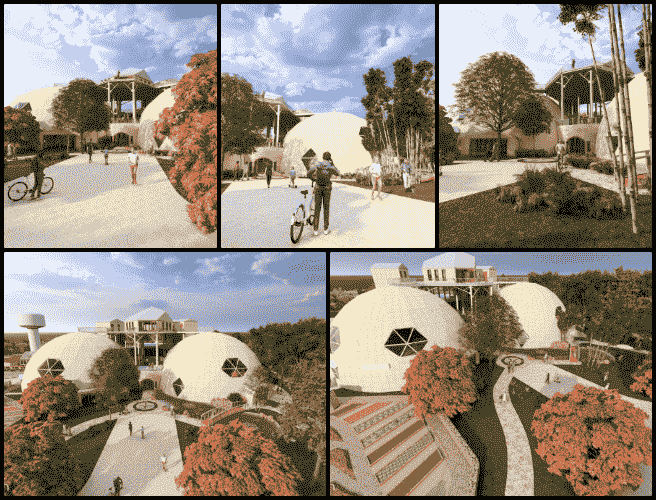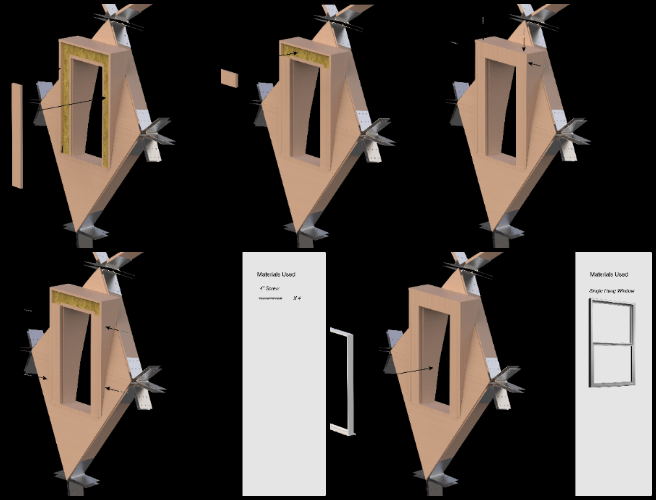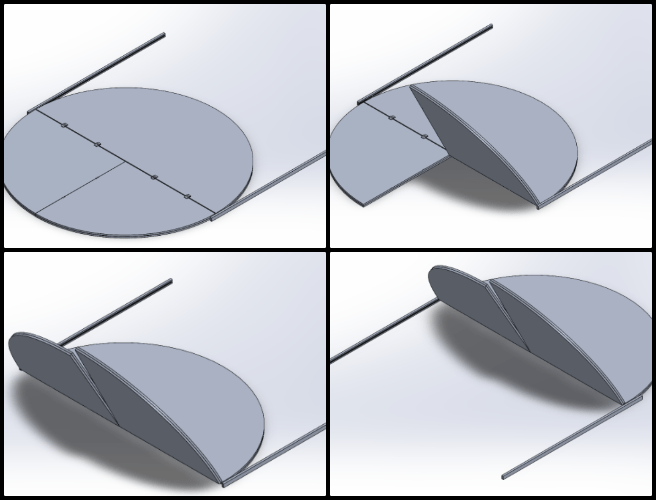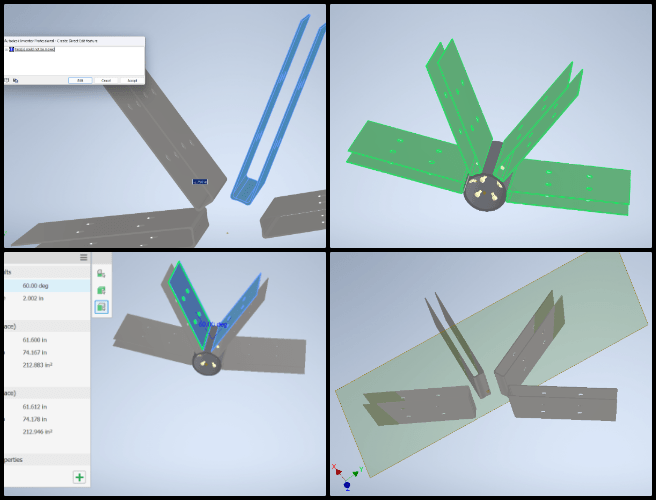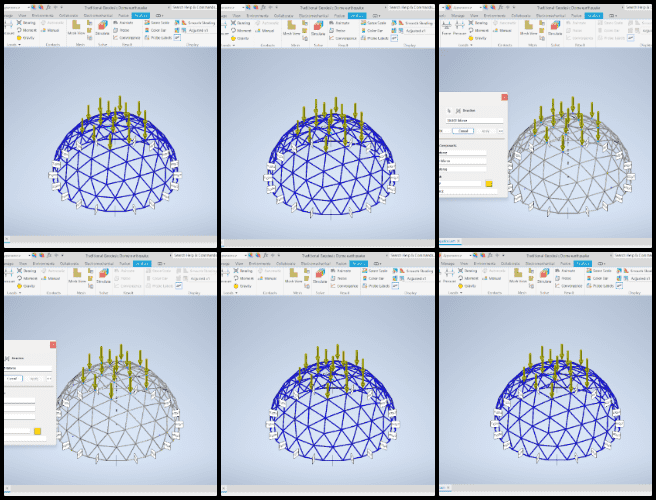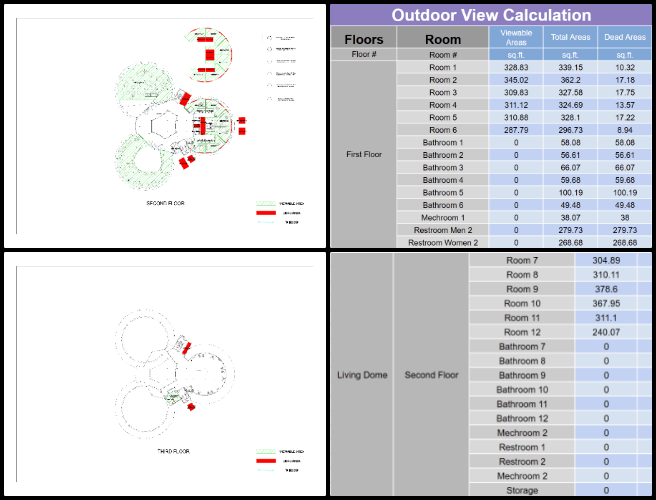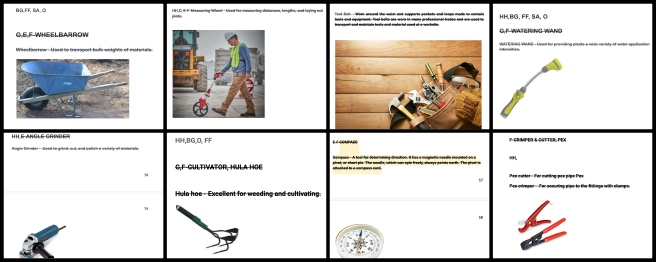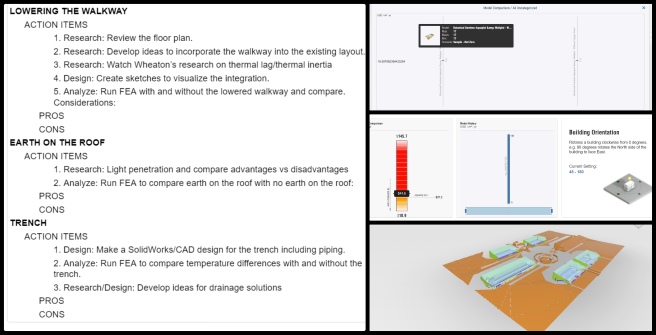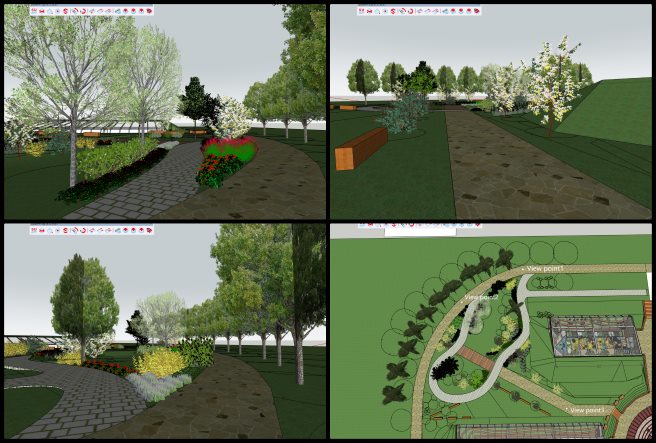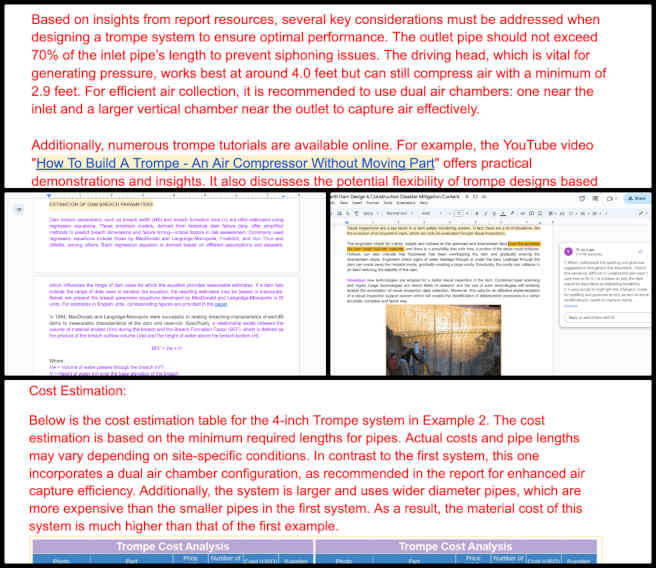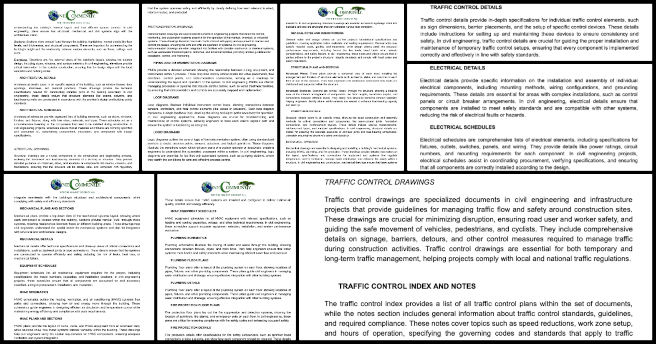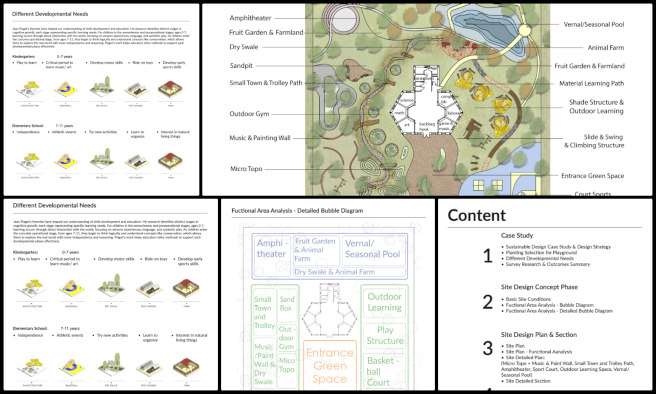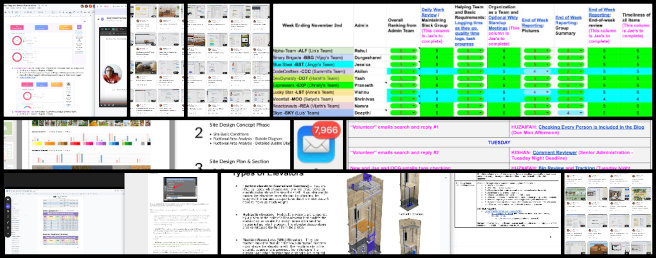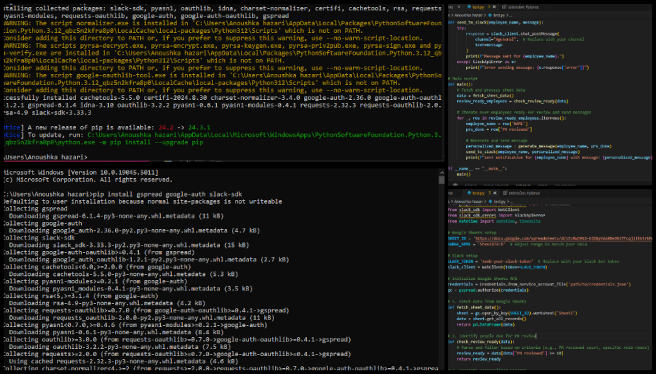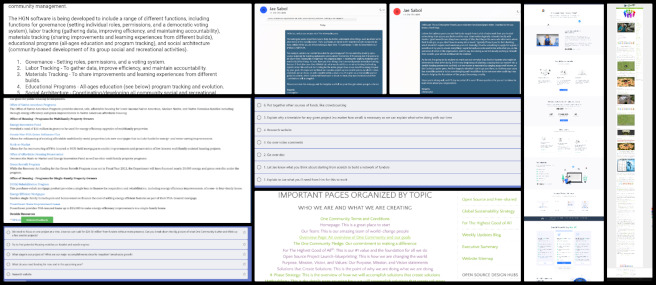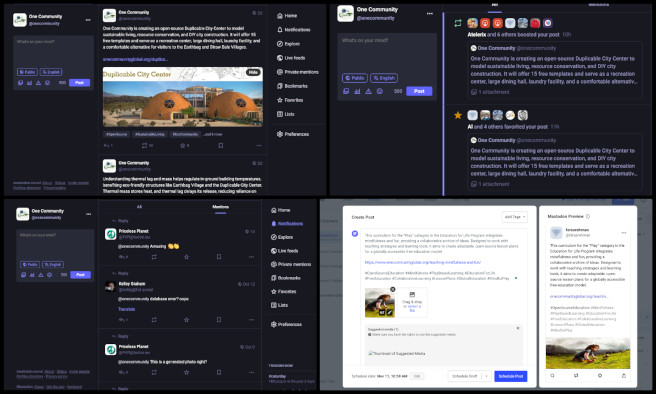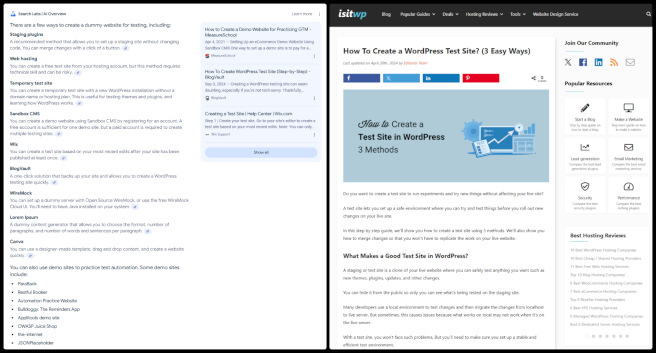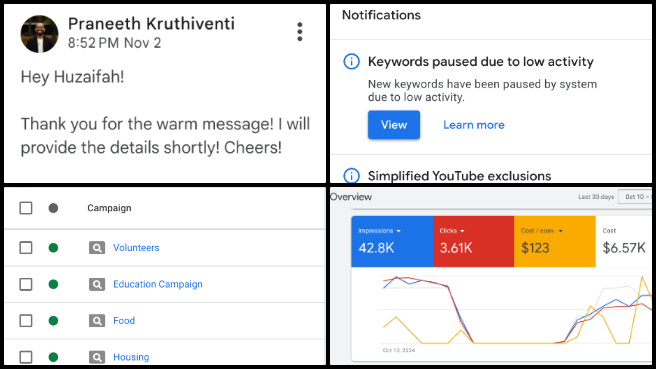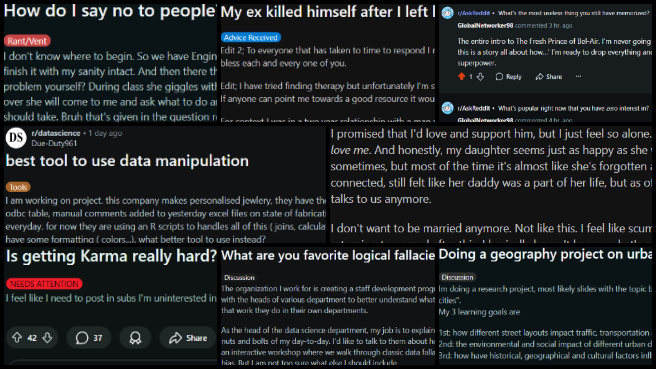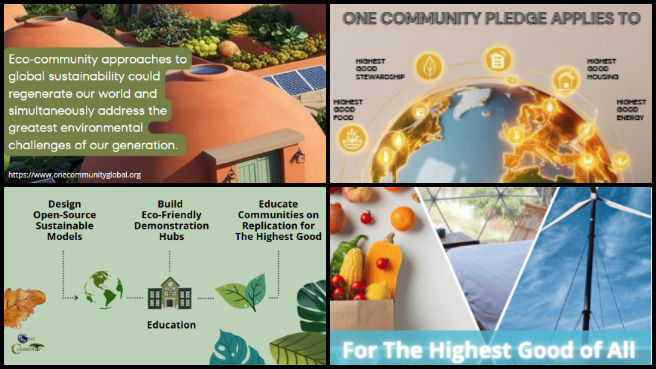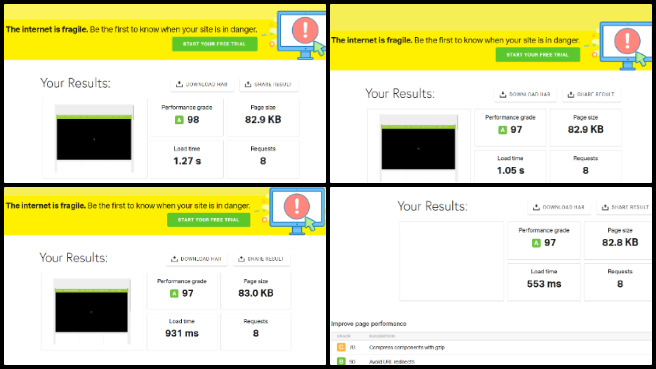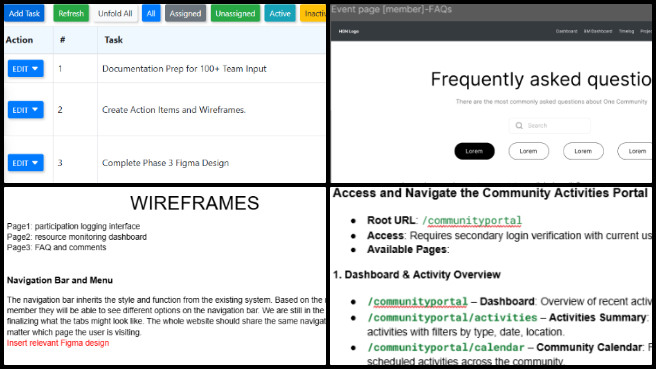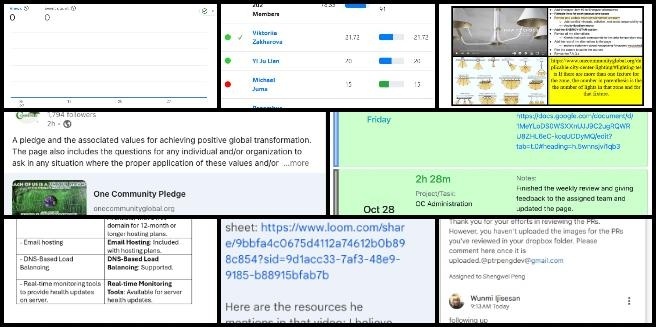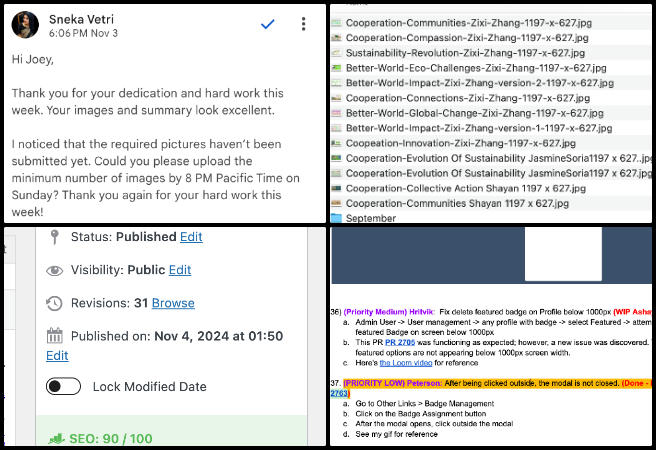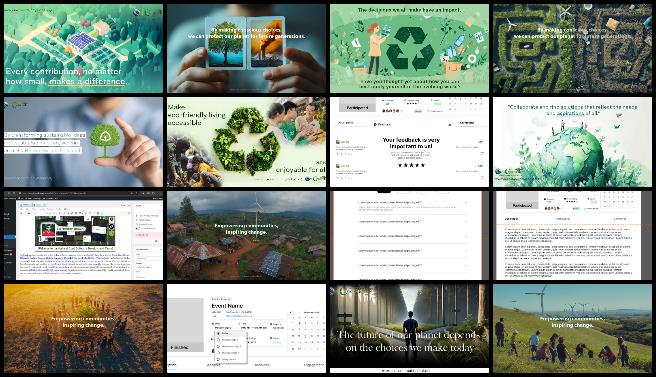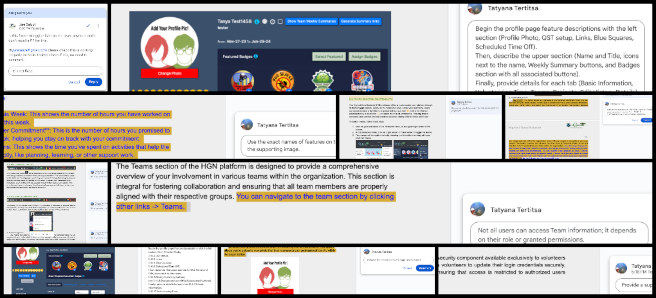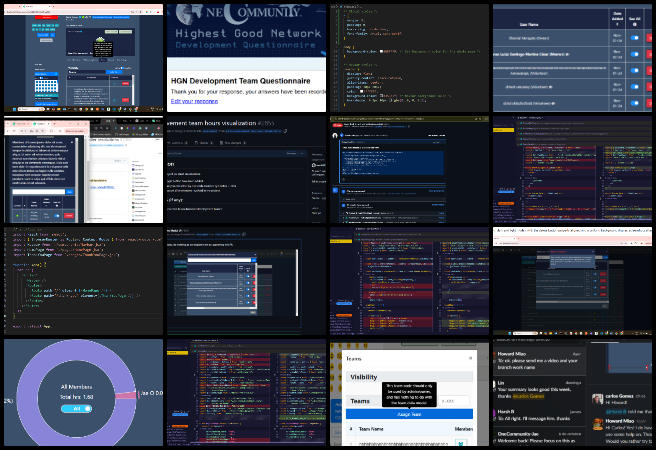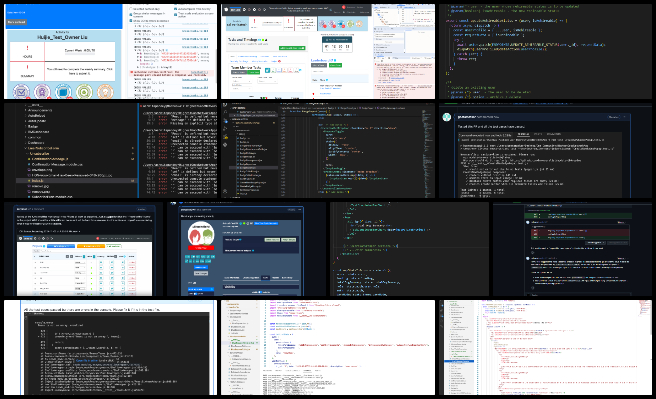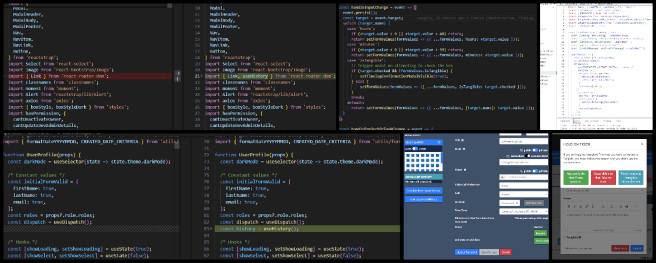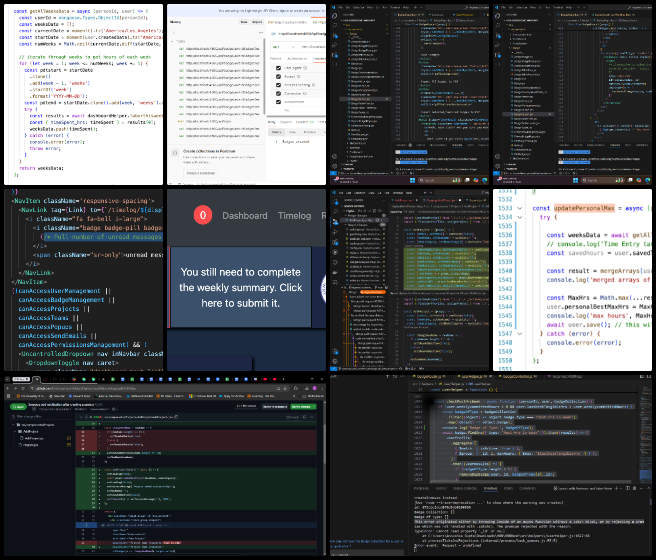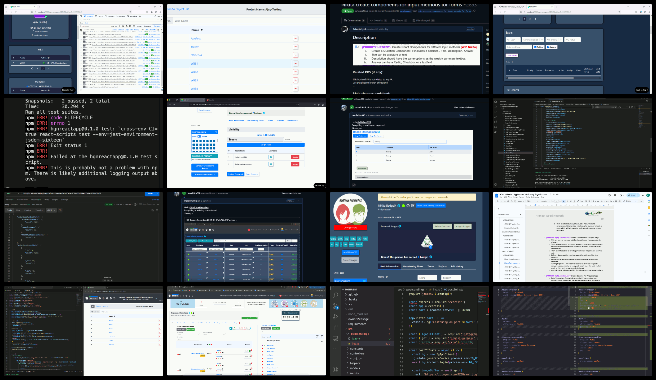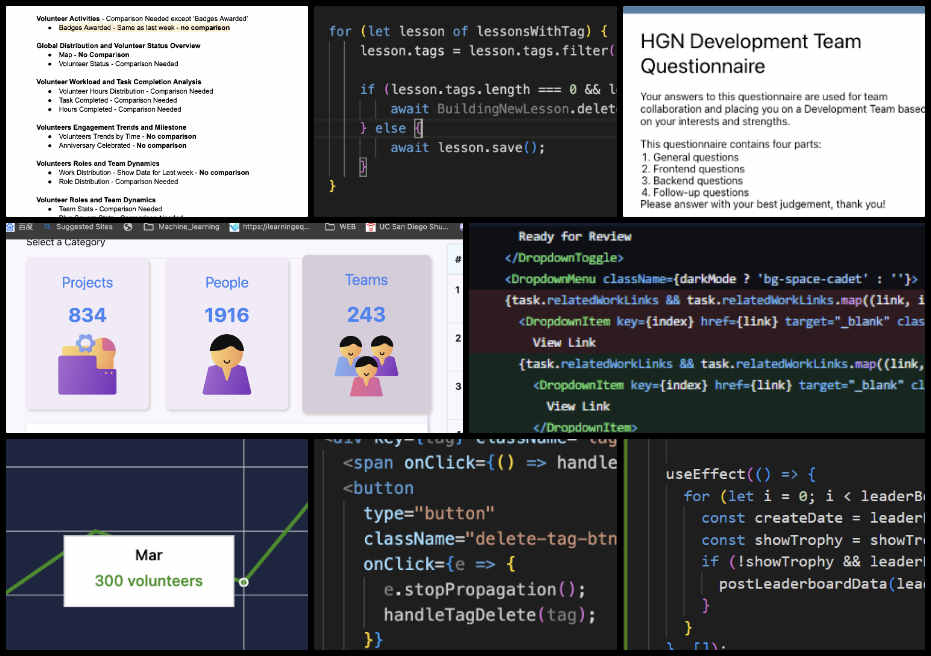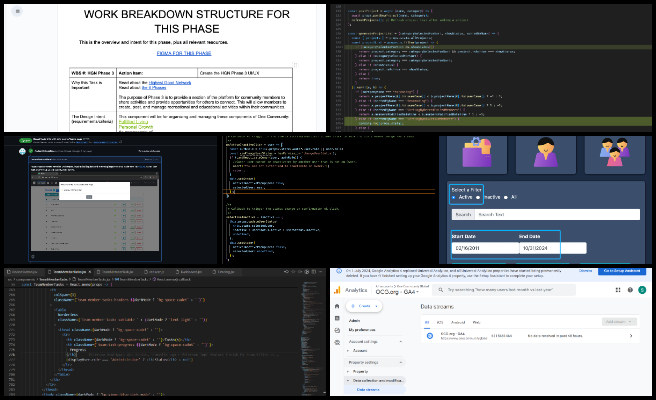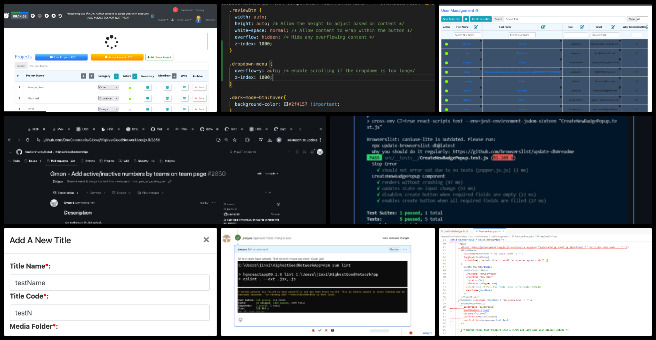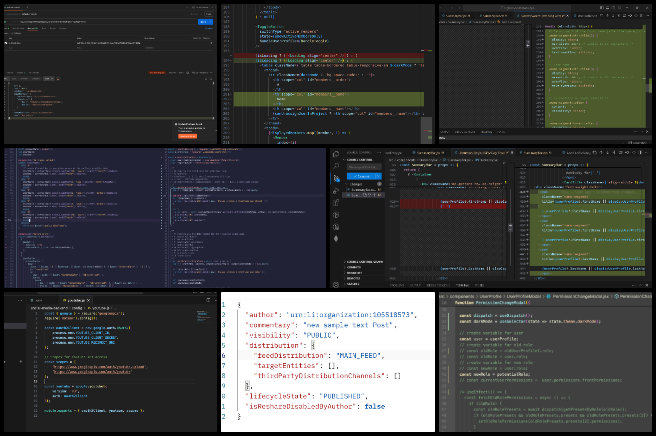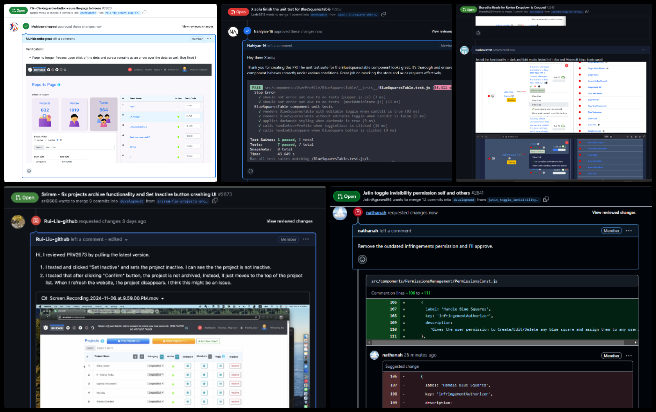Creating Patterns of Positive Change – One Community Weekly Progress Update #608
At One Community, we are creating patterns of positive change to regenerate our planet and create a world that works for everyone. Our all-volunteer team is focused on sustainable approaches to food, energy, housing, education, economics, and social architecture. By open sourcing and free sharing the complete process, we aim to build a self-replicating model that inspires a global collaboration of teacher/demonstration hubs, all for “The Highest Good of All.” Together, we are evolving sustainability and fostering global stewardship practices that promote fulfilled living and lasting progress.
- Here’s our project overview
- Here’s our world-change methodology
- Here’s how this becomes self-replicating
- Here’s how we are open source and free-sharing all the do-it-yourself designs
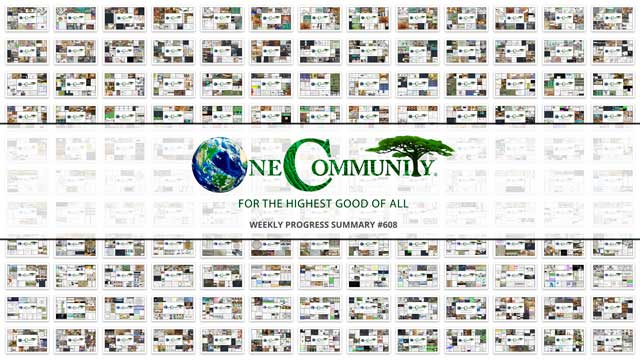
OUR MAIN OPEN SOURCE HUBS
Click on each icon to be taken to the corresponding Highest Good hub page.
One Community’s physical location will forward this movement as the first of many creating patterns of positive change as self-replicating teacher/demonstration communities, villages, and cities to be built around the world. This is the November 11th, 2024 edition (#608) of our weekly progress update detailing our team’s development and accomplishments:
Creating Patterns of Positive Change
One Community Progress Update #608
DONATE | COLLABORATE | HELP WITH LARGE-SCALE FUNDING
CLICK HERE IF YOU’D LIKE TO RECEIVE AN EMAIL EACH WEEK WHEN WE RELEASE A NEW UPDATE
YOU CAN ALSO JOIN US THROUGH SOCIAL MEDIA
ONE COMMUNITY WEEKLY UPDATE DETAILS
HIGHEST GOOD HOUSING PROGRESS
 One Community is creating patterns of positive change through Highest Good housing that is artistic and beautiful, more affordable, more space efficient, lasts longer, DIY buildable, and constructed with healthy and sustainable materials:
One Community is creating patterns of positive change through Highest Good housing that is artistic and beautiful, more affordable, more space efficient, lasts longer, DIY buildable, and constructed with healthy and sustainable materials:
- Learn about: Our Upcoming Crowdfunding Campaign
- Learn about the different village models: 7 Sustainable Village Models
- Visit the open source portals for the first two: Earthbag Village OS Hub | Straw Bale Village OS Hub
This week, Adil Zulfiquar (Engineer) continued working on the Vermiculture Toilet designs. He focused on updating the rendering of the vermiculture structure to reflect the latest design, and related information was revised. Titles and headings were adjusted to better align with the content of each section, and additional resources and references used for calculations were added for clarity. The context for the narrow-body design trailer was also revised. The Earthbag Village is the first of 7 to be built as the housing component of One Community’s open source model for creating patterns of positive change. See below for some of the pictures related to this work.
Akshit Sethi (Architectural Designer) continued working on updating the Earthbag Village SketchUp and AutoCAD layouts. Akshit updated the base drawing set for the EarthBag Village, refining layers to improve readability and prepare the drawings for publication. He advanced work on the 3D model to align with the revised CAD file and collaborated with a team member to confirm accurate sizing of the service ramp. These updates aimed to enhance precision and clarity within the project documentation. The Earthbag village is the first of 7 villages to be built as part of One Community’s open source model for creating patterns of positive change. See his work in the collage below.
Anil Karathra (Mechanical Engineer) continued helping complete the Vermiculture Toilet designs. Anil uploaded and formatted all recent documents in the vermiculture collaboration file and incorporated the latest feedback. He discussed exit tasks and checklists with Yagyansh and reviewed weekly tasks and progress with Manjiri. He completed research on worm density and population dynamics in vermiculture, documented the findings, and initiated research on odor and pest control strategies. Anil led the weekly team meeting, conducted new finite element analysis on the slider, and reviewed and organized work completed by Yuze. Additionally, he held an introductory call with Manjiri to guide her through the project and associated documents. The approach for creating patterns of positive change enables the development of innovative solutions that are both environmentally friendly and effective. See below for some of the pictures related to this work.
Avery Hamilton (Mechanical Designer) continued working on finalizing the interior of the Earthbag Village 4-dome home design. Avery created a coordination document for MEP items, detailing fixture selections, equipment code requirements, and equipment locations to streamline project alignment. He updated the model to include more accurate equipment based on project specifications and initiated the layout of refrigerant piping to indoor AC units to support system design. This work focused on improving the integration and alignment of mechanical elements within the overall design. The Earthbag village is the first of 7 villages to be built as part of One Community’s open source model for creating patterns of positive change. See his work in the collage below.
Joseph Osayande (Mechanical Engineer) also continued helping finish the Vermiculture Toilet engineering and design details. He focused on finalizing modifications to the Waste Removal Stand (WRS), identifying that the selected unistrut material may deform under the load at the winch attachment point. A stronger steel is recommended to prevent potential breakage from repeated use. All L-brackets were adjusted to support the weight of the steel plate, and the unistruts were confirmed to handle human weight. Additional finite element analysis will be performed on the connecting piece to explore materials that offer better reinforcement for the winch’s pulling function. The Earthbag Village is the first of 7 to be built as the housing component of One Community’s open source model for creating patterns of positive change. See some of his work in the collage below.
Karthik Pillai (Mechanical Engineer) continued helping finish the Vermiculture Toilet engineering and helping with the Earthbag Village 4-dome home roof plan. Karthik refined the four-dome cluster roof project by using finite element analysis (FEA) to evaluate various joist designs and optimize structural performance. This involved testing multiple iterations to determine optimal joist dimensions for stability and effective load distribution per mechanical engineering standards. Concurrently, he worked on the vermiculture toilet design, making adjustments to the main assembly to reduce overflow by minimizing gap sizes. The team also collaborated on engineering solutions to prevent material leakage, exploring design modifications to enhance fluid containment and system efficiency. The Earthbag Village is the first of 7 to be built as the housing component of One Community’s open source model for creating patterns of positive change. See some of his work in the collage below.
Michaela Silva (Architect) continued working on finalizing the interior details for the Earthbag Village 4-dome home design. Michaela researched recommended minimum light levels for residential spaces and calculated the required number of fixtures for each area to meet these standards. She developed a layout for the light fixtures and shared the updated plans for electrical coordination. Additionally, she facilitated a roof structure meeting, guiding the team through code research on maximum deflection and the specifications for live and dead load calculations. The Earthbag Village is the first of 7 villages to be built as part of One Community’s open source model for creating patterns of positive change. See her work in the collage below.
Prarthana Jathar (Architectural Designer) continued working on AutoCAD tasks and the Earthbag Village 4-dome home interior renders. Prarthana calculated the footprint of the Duplicable City Center and formatted the output into PDFs. She developed a Photoshop library for internal renders of the 4-dome cluster and produced internal renders using Rhino and Photoshop. Additionally, she refined the internal living room renders for the 4-dome cluster, utilizing Photoshop for visual enhancements. The Earthbag Village is the first of 7 to be built as the housing component of One Community’s open source model for creating patterns of positive change. Take a look at some of this work in the images below.
Vimarsh Acharya (Engineering Manager and Technical Reviewer) continued working on identifying sustainability-related arguments covering Highest Good Lifestyle Considerations and sourcing quality research to support each one. He gathered 20 peer-reviewed papers for each topic, prioritizing studies with clear relevance to sustainability objectives. His research covered environmental, economic, and social impacts, emphasizing practical solutions such as community recycling, waste reduction, and resource conservation. Each study was selected for its direct contribution to sustainability, with particular attention to areas like greenhouse gas reduction, resource management, and environmental policy support. The One Community model of combining forward-thinking education with sustainably built classrooms like this is an excellent example of creating patterns of positive change. See the collage below for his work.
DUPLICABLE CITY CENTER PROGRESS
 One Community is creating patterns of positive change through a Duplicable and Sustainable City Center that is LEED Platinum certified/Sustainable, can feed 200 people at a time, provide laundry for over 300 people, is beautiful, spacious, and saves resources, money, and space:
One Community is creating patterns of positive change through a Duplicable and Sustainable City Center that is LEED Platinum certified/Sustainable, can feed 200 people at a time, provide laundry for over 300 people, is beautiful, spacious, and saves resources, money, and space:
- Learn about this building and it’s function in creating patterns of positive change: Duplicable City Center Open Source Hub
This week, Arnob Mutsuddi (Mechanical Engineer) continued working on the City Center Dome Hub Connector Engineering model and details. The row 2 hub connector design was completed and design work for the row 4 hub connector was initiated and continued. The row 4 hub connector design progressed with a focus on angle alignment, middle ring integration, and the alignment of four side struts with the middle ring. A team meeting was held to discuss work progress, during which guidance was provided on the snow load test simulation to ensure realistic load values. Row 4 hub connector design continued, reaching 85% completion. The Duplicable City Center is a foundational part of One Community’s open-source model, which excels in creating patterns of positive change. This approach is integral to their mission of creating patterns of positive change through innovative and scalable solutions. See some of this work in the pictures below.
Chris Blair (GIS Technician/Horticulturist) continued working with GIS data as part of One Community’s Permaculture Design that includes the location of the Duplicable City Center. He continued learning how to use QGIS, an open-source GIS software, with the goal of recreating his previous work from proprietary software to improve future data access. He imported updated blueprints into QGIS and continued scaling, digitizing, and georeferencing the villages and community center based on revised area measurements of their footprints. Within One Community’s open-source framework, the Duplicable City Center plays a central role in creating patterns of positive change. The images below showcase some of this work.
Faeq Abu Alia (Architectural Engineer) continued his work on the Duplicable City Center Eco-kitchen renders. He continued refining the Duplicable City Center kitchen model in SketchUp by addressing feedback, correcting model issues, and adding elements like food and human figures to enhance realism. In Lumion, he adjusted materials, incorporated additional human figures, and rendered essential video shots to improve the walkthrough presentation. These updates were made to align with project feedback and increase the overall quality of the visual experience. The Duplicable City Center represents a fundamental element of One Community’s open-source approach, dedicated to creating patterns of positive change. View examples of this work in the pictures provided below.
Jason Bao (Architectural Designer) began his work on producing renders for the Duplicable City Center library. Initial tasks included setting up Lumion live-sync with SketchUp, removing unnecessary elements from the model, and testing night render settings. Adjustments focused on lighting effects, material textures, and render quality, including refining angles, brightness, and reflections. Additional lights and objects were placed to enhance realism, with a specific focus on a “sport night” scene setup. Render tests were uploaded for further review and feedback. As a foundational component of One Community’s open-source strategy, the Duplicable City Center is designed for creating patterns of positive change. The images below showcase some of this work.
Mohammed Maaz Siddiqui (Architect) worked on the outdoor landscape areas for the Duplicable City Center project. He planted trees based on the designated landscape map, ensuring each was positioned according to the planned layout. He also incorporated figures to add liveliness to the renders, completing the work with final rendering adjustments. Within One Community’s open-source framework, the Duplicable City Center plays a central role in creating patterns of positive change. The images below showcase some of this work.
Nika Gavran (Industrial Designer) continued her work on the Duplicable City Center dormer window installation plans. This week, Nika expanded the final dormer window assembly document, focusing on the next steps for the exterior assembly. With the window fully assembled, she placed all renders into the final graphic format, removed shadows, and added directional graphics, such as arrows, to improve clarity in the instructions. She continued compiling slides and made progress on finalizing the document. As a foundational component of One Community’s open-source strategy, the Duplicable City Center is designed for creating patterns of positive change. The images below showcase some of this work.
Nimika Devi (Architect) continued woking on the Duplicable City Center outdoor back areas. This week, she developed a detailed 3D exterior model of a greenhouse for the Duplicable City Center. The process involved enhancing the model with additional architectural elements and interactive features to improve the visual experience. High-definition renders were exported, and a comprehensive walkthrough of the model was produced to showcase the greenhouse design and its integration within the city center. These visualizations focused on the structure’s aesthetic and functional aspects, providing a clear representation of the proposed design in an immersive format. Within One Community’s open-source framework, the Duplicable City Center plays a central role in creating patterns of positive change. The images below showcase some of this work.
Sanket Basannavar (Mechanical Engineer) continued working on the Duplicable City Center spa cover as part of the City Center Natural Pool and Eco-spa Designs. This week, he continued his research on the structure and materials used in spa covers currently available in the market. He refined the spa cover design and conducted stress analysis to assess its load-bearing capacity. The analysis revealed that the current design could not withstand a load of 200 pounds, identifying structural areas needing reinforcement or material adjustments to enhance durability. These findings from the stress test will inform necessary modifications to meet safety and functional specifications. Within One Community’s open-source framework, the Duplicable City Center plays a central role in creating patterns of positive change. The images below showcase some of this work.
Tasmia Hasan (Design Engineer) continued her work on the structural engineering of the Duplicable City Center. She worked on modifying the hub connector design by adjusting specific edges to meet a 66-degree angle requirement, though challenges arose due to issues with the movement of certain faces within the model. Additionally, Tasmia participated in a team meeting to review and discuss the project’s overall design approach. As a foundational component of One Community’s open-source strategy, the Duplicable City Center is designed for creating patterns of positive change. You can see examples of this work in the following images.
Umema Ali (Mechanical Design Engineer) continued working on the Duplicable City Center Engineering. She focused on static structural analysis of a traditional structure subjected to snow loads of 10 and 20 lbs. Using Autodesk Inventor, she analyzed the effects of a uniformly distributed load, specifically examining displacement and stress values. Her work included assessing how the structure responded to these load levels, with attention to both displacement and internal stress distribution. This analysis generated data on the structure’s stability under varying snow load conditions, identifying key insights into its resilience and highlighting potential structural vulnerabilities. Within One Community’s open-source framework, the Duplicable City Center plays a central role in creating patterns of positive change. The images below showcase some of this work.
Yancong E (Architectural Designer) continued working on the Duplicable City Center project. He continued updating the Outdoor View floor plan labels to align with the latest floor plan revisions, completing the labeling for the second and third floors. Yancong also recalculated the Outdoor View Percentage and finalized the view calculations for each room in the living dome on the first and second floors. The Duplicable City Center represents a fundamental element of One Community’s open-source approach, dedicated to creating patterns of positive change. This innovative initiative aims to showcase how creating patterns of positive change can transform urban spaces into more sustainable and community-oriented environments. You can see examples of this work in the following images.
HIGHEST GOOD FOOD PROGRESS
 One Community is creating patterns of positive change through Highest Good food that is more diverse, more nutritious, locally grown and sustainable, and part of our open source botanical garden model to support and share bio-diversity:
One Community is creating patterns of positive change through Highest Good food that is more diverse, more nutritious, locally grown and sustainable, and part of our open source botanical garden model to support and share bio-diversity:
- Learn about the structures: Hoop House Hub | Aquapini & Walipini Open Source Hub
- See what we’ll be growing and creating patterns of positive change: Gardens & Hoop Houses | Large-scale Structures | Food Forest | TA
This week, the core team initiated and completed the Hoop House Tools, Equipment, Materials/Supplies list. The primary purpose of the hoop houses is to extend the growing season on each end to benefit from an additional two to three month growing season. They also protect plants from wind, frost, snow, ice, heavy rain, extreme temperatures as well as disease and pest infestations and can result in a higher crop yield and quality. Photos were also added for the items and designated on the master list with an “HH” designation. The Highest Good Food initiative is a key component of One Community’s open source plans, dedicated to creating patterns of positive change. See their work in the collage below.
Jay Nair (BIM Designer) continued working on Aquapini and Walipini Planting and Harvesting lighting and HVAC design. He focused on building a multidisciplinary team for the greenhouse project, identifying key roles necessary for design and analysis, including specialists in HVAC design, structural engineering, and botany. The work also included in-depth research on incorporating climate battery systems to enhance temperature regulation and energy efficiency within the greenhouse. Additionally, research extended to evaluating analysis capabilities within Revit software to understand the feasibility of conducting FEA simulations and integrating HVAC components for comprehensive thermal modeling and optimization. The Highest Good Food initiative is a key component of One Community’s open source plans, dedicated to creating patterns of positive change, and exemplifies the organization’s commitment to creating patterns of positive change through innovative design and implementation. Below are some of the images showcasing this work.
Purva Borkar (Landscape Architect) continued her work on creating an outdoor merge of a food-producing ecosystem and people spaces for the Aquapini and Walipini Planting and Harvesting structures. She worked on CAD drawings that require a detailed understanding of bioswale design, focusing on depth, slope, vegetation, and soil composition to optimize water filtration and flow control. She also detailed inflow and outflow points, erosion prevention, and plant selection, ensuring each bioswale captures runoff, reduces pollutants, and supports sustainable site functionality. As part of One Community’s open source efforts, the Highest Good Food initiative embodies a commitment to creating patterns of positive change. The images below offer a glimpse into these ongoing efforts.
Vatsal Tapiawala (Mechanical Engineer) continued working on integrating ideas from Paul Wheaton’s Truly Passive Greenhouse” designs into the Aquapini/Walipinis structures. He formatted his research for the passive greenhouse project according to One Community’s website guidelines. Additionally, he created a list of action items to integrate the ideas into the design and perform various analyses. Vatsal also performed an initial energy simulation for the entire model and considered ideas to include a lowered walkway in the design. The Highest Good Food initiative is a key component of One Community’s open source plans, dedicated to creating patterns of positive change. See his work in the collage below.
Ziyi Chen (Landscape Designer) continued working on the design of the outdoor spaces for the Aquapini/Walipinis structures. She continued selecting tree species and refining her models. She completed most of the construction in the southeast section of the Four Seasons area, using wintergreen and different types of sage to create a transition between the district and the outermost road. The plantings on both sides of the road were arranged in a staggered pattern to enhance the overall appearance. Ziyi also added dogwood as understory planting along the road leading from the central compass to the food forest. On the opposite side, she planted low-growing berry shrubs between the seating areas to reduce shading on the Walipini structure, allowing people to sit on the benches and view the interior of the Walipini through its roof. The Highest Good Food initiative is a key component of One Community’s open source plans, dedicated to creating patterns of positive change. See her work in the collage below.
HIGHEST GOOD ENERGY PROGRESS
 One Community is creating patterns of positive change through Highest Good energy that is more sustainable, resilient, supports self-sufficiency and includes solar, wind, hydro and more:
One Community is creating patterns of positive change through Highest Good energy that is more sustainable, resilient, supports self-sufficiency and includes solar, wind, hydro and more:
- Learn about the open source sustainable-energy foundations: Solar, Hydro, and Wind
- Explore our research into the most sustainable products and companies for saving water and energy: Insulation, Eco-laundry, Lightbulbs and Light Bulb Companies, Doors and Door Companies, Windows and Window Companies, Toilets, Faucets and Faucet Accessories, Urinals, and more.
This week, Panambur Rachan Rao (Project Manager) continued revising the Highest Good Energy cost analysis spreadsheet. This week he used data from the Department of Energy and NREL websites to estimate costs for various renewable energy options. He factored in the energy requirements for the Earthbag Village and Duplicable City Center. Additionally, Rachan checked in on the DCC team’s weekly progress to track the status of their tasks. The team has made progress within One Community’s open-source framework, with the Duplicable City Center playing a central role in creating patterns of positive change. Take a look at some of this work in the images below.
Viktoriia Zakharova (Administrative Assistant) continued her research to complete the update of the Most Sustainable Lightbulbs and Light Bulb Companies. This week’s focus was completing an inventory of fixtures chosen for the Duplicable City Center through computational modeling. She created a list of sustainable lighting fixture companies for further research and defined specific product evaluation criteria. Additionally, she reviewed seven scientific articles covering advancements and recent innovations in the lighting fixture industry. Viktoriia also fulfilled her administrative responsibilities. The Duplicable City Center represents a fundamental element of One Community’s open-source approach, which is dedicated to creating patterns of positive change. View examples of this work in the pictures provided below.
Yi-Ju Lien (Environmental Engineer) refined her work on the Hydro Energy Exploration and Open Source DIY Dam Design for Water Retention, Pond and Lake Creation, etc. tutorials. She reviewed the work on the sustainable parking lot and pavement design and gained a better understanding of the current plan for the earthbag village, which helped her grasp the overall project context. The review further allowed her to consider the project’s potential for stormwater management. These open source energy contributors are a fundamental element of One Community’s open-source approach, which is dedicated to creating patterns of positive change. Below is a collage of this work.
HIGHEST GOOD EDUCATION PROGRESS
 One Community is creating patterns of positive change through Highest Good education that is for all ages, applicable in any environment, adaptable to individual needs, far exceeds traditional education standards, and more fun for both the teachers and the students. This component of One Community is about 95% complete with only the Open Source School Licensing and Ultimate Classroom construction and assembly details remaining to be finished. We’ll report on the final two elements to be finished as we develop them. With over 8 years of work invested in the process, the sections below are all complete until we move onto the property and continue the development and open sourcing process with teachers and students – a development process that is built directly into the structure of the education program and everything else we’re creating too:
One Community is creating patterns of positive change through Highest Good education that is for all ages, applicable in any environment, adaptable to individual needs, far exceeds traditional education standards, and more fun for both the teachers and the students. This component of One Community is about 95% complete with only the Open Source School Licensing and Ultimate Classroom construction and assembly details remaining to be finished. We’ll report on the final two elements to be finished as we develop them. With over 8 years of work invested in the process, the sections below are all complete until we move onto the property and continue the development and open sourcing process with teachers and students – a development process that is built directly into the structure of the education program and everything else we’re creating too:
- Program Overview: Education Open Source Hub
- How the components work together in creating patterns of positive change: How to use the Education for Life Program
This week, Apoorv Pandey (Mechanical Engineer) continued helping with the structural engineering details for the Ultimate Classroom part of the Highest Good education component. He continued working on the final draft of the Structural Engineering Report, focusing on the calculations and analysis section and the drawings in the AutoCAD file. He researched ways to simplify the explanation of technical tables, such as the static check table and the beam force detail summary, to make the content more accessible to a layperson. Given the complexity of the results, he sought assistance from Jae to help complete the report. Additionally, Apoorv is reworking the formatting of certain sections and referencing other published materials on One Community’s website to guide his work. The One Community model of combining forward-thinking education with sustainably built classrooms like this is an excellent example of creating patterns of positive change. This approach exemplifies creating patterns of positive change by creating environments fostering collaboration and innovation. See the collage below for his work.
Brian Mwoyowatidi (Graduate Structural Engineer) continued helping with the footer, foundation, and flooring engineering details for the Ultimate Classroom part of the Highest Good education component. He focused on the Footers section of the Engineering Report and Tutorial, adding images illustrating footer design considerations based on ACI 318-19. He also included a new video section outlining the drainage and waterproofing installation process for use during the construction phase of the Ultimate Classroom. In the reinforcement section, he added an image to visually support footing reinforcement as typically assembled on-site. Brian completed the final integration of feedback, adding backup links to Dropbox for the AutoCAD plans covering the footer, foundation, and flooring systems, and he completed the final proofreading of the report and tutorial. The One Community model of combining forward-thinking education with sustainably built classrooms like this is an excellent example of creating patterns of positive change. This approach exemplifies creating patterns of positive change by creating environments fostering collaboration and innovation. See the collage below for his work.
Ritu Damani (Graphic Designer) helped by finishing another revision of the Ultimate Classroom overview. She concluded her work on the ultimate classroom project layout task based on feedback, correcting errors, and implementing layout changes as well as creating a few more social media images and rectifying the previous one. She also created a volunteer announcement for herself that is to be published. This approach exemplifies creating patterns of positive change by creating environments fostering collaboration and innovation. See the collage below for his work.
HIGHEST GOOD SOCIETY PROGRESS
 One Community is creating patterns of positive change through a Highest Good society approach to living that is founded on fulfilled living, the study of meeting human needs, Community, and making a difference in the world:
One Community is creating patterns of positive change through a Highest Good society approach to living that is founded on fulfilled living, the study of meeting human needs, Community, and making a difference in the world:
- Read the Highest Good society overview: Highest Good Society
- Learn about the model for fulfilled living and sharing and creating patterns of positive change: A Day in the Life
- Learn about the 4 economic models: RBE | For-profit | Non-profit | Entrepreneurship
- Learn about our open source community collaboration and management software: The Highest Good Network
This week, the core team completed over 58 hours managing One Community’s volunteer-work review not included above, emails, social media accounts, web development, new bug identification and bug-fix integration for the Highest Good Network software, and interviewing and getting set up new volunteer team members. They also shot and incorporated the video above that talks about creating patterns of positive change and how creating patterns of positive change is a foundation of the bigger picture of everything One Community is doing. The image below shows some of this work.
Anoushka Hazari (Data Analyst) continued working on code for automating and simplifying the Highest Good Network software promotion process. This week she focused on implementing the code for Slack integration, specifically working on automating notifications and real-time updates for team channels. The initial steps involved addressing challenges with the ID and `gspread` imports in the code. Additionally, she spent time reviewing Google videos related to importing the Slack API, although the time spent on this task was not logged before proceeding to write the actual code. This work helps One Community’s mission of creating patterns of positive change and reinforces our commitment to creating patterns of positive change. The following images show his work for the week.
Aravind Yuvraj (Cyber Security Professional) continued helping with the One Community website and Highest Good Network software stability and security. This week he focused on obtaining the necessary backend files to support hosting on an alternative platform, which included reviewing files within Azure. Efforts continued in Azure’s database, concentrating on creating and saving backups. Site stability for One Community Global was monitored, alongside work for transitioning the HGN site from Azure to a different hosting platform. Additionally, he checked for general site stability monitoring, and further checks were performed on HGN for the upcoming transfer. This work helps One Community’s mission of creating patterns of positive change and reinforces our commitment to creating patterns of positive change. The following images show his work for the week.
Christopher Powell (Grant Writer) joined the team and began helping with grant writing as a source of funding. This week, he had an in-depth discussion with Jae to gain a deeper understanding of One Community’s goals, functions, and the project’s current status. He worked extensively on the template document, adding notes and questions, and developed an initial strategy for determining priorities and the approach to take moving forward. Christopher also reviewed the website and several key documents to gain deeper insight into One Community’s internal operations and long-term vision. This work helps One Community’s mission of creating patterns of positive change and reinforces our commitment to creating patterns of positive change. The following images show his work for the week.
Feras Rehman (Data Analyst) continued working on developing One Community’s Mastodon account and strategy. He also managed his part of the One Community Updates Blog and reviewed Rahul’s work, providing feedback on identified errors. Five additional posts for Mastodon were scheduled on Buffer the following week, leading to a threefold increase in post reach through optimized hashtag selection and refined post structuring. The weekly summary was completed, and images were added to supplement the content. This work helps One Community’s mission of creating patterns of positive change and reinforces our commitment to creating patterns of positive change. The following images show his work for the week.
Gavin Burk (Project Manager) continued to lead the tech team in addressing website and Highest Good Network software issues. This week he researched sustainable building methods and permitting procedures to identify key considerations for obtaining permits and began drafting a list of items to include on the webpage. He also worked with the team to establish new priorities for website improvements and created an action item list to clarify responsibilities across team members. This work helps One Community’s mission of creating patterns of positive change and reinforces our commitment to creating patterns of positive change. The following images show his work for the week.
Praneeth Kruthiventi (Volunteer Data Analyst) continued helping manager the One Community Google Ads campaigns. This week’s focus was addressing issues with the active Google Ads campaigns and optimized keywords and descriptions. He completed his study of Google Analytics using instructional materials provided in a shared document and completed the Google Analytics certification. Additionally, he submitted his photo and bio for the One Community collaboration page. This work supports One Community’s mission and reinforces our commitment to creating patterns of positive change. The images below showcase his work for the week.
Rahul Bavanandan (Data Analyst) continued working on several key projects within the Highest Good Network software, One Community’s Reddit presence, and administration. For the HGN Phase 2 Evolution, he concentrated on translating Figma designs into the Phase 2 dashboard, aiming for consistency with the Phase 1 interface. His marketing efforts included building a presence on Reddit, where he engaged in relevant subreddit conversations to strengthen his standing and prepare for sharing content related to One Community. Additionally, he contributed to the weekly update by curating content, adding summaries and photo collages to the website, and reviewing submissions from team members to ensure alignment with organizational standards and enhance the quality of posted materials. This work supports One Community’s mission and reinforces our commitment to creating patterns of positive change. The images below showcase his work for the week.
Shireen Kayal (Humanitarian Program Developer & Data Manager) continued her work on branding graphics for all of One Community. This week she created new graphics for both the Highest Good Food Page and the For The Highest Good of All® philosophy page. Additionally, she designed eleven infographics intended for social media use and to accompany longer text on the website, making the information more accessible and visually appealing. This work supports One Community’s mission and reinforces our commitment to creating patterns of positive change. The images below showcase her work for the week.
Shrinivas Patil (Software Engineer) completed his blog 607 and submitted individual feedback for each member of Team Moonfall. He reviewed the contributions of two other admins, providing them feedback on their summaries, images, and video submissions, and assisted Sara in tracking feedback on the admin feedback spreadsheet. He also monitored the HGN PR reviews tracking sheet, identifying urgent and high-priority tasks, marking completed and raised PRs ready for review. Additionally, he followed up with team members on Slack regarding their progress on specific PRs, integrating updates into the tracking spreadsheet. This work supports One Community’s mission and reinforces our commitment to creating patterns of positive change. The images below showcase his work for the week.
Venkata Jaya Pavan Naru (Volunteer Network And Cybersecurity Engineer) continued helping with the One Community website and Highest Good Network software stability and security. This week he adjusted PHP settings, verified active plugins, and optimized website speed through PHP modifications and web maintenance. They checked for unnecessary plugins, cleared the database cache, and conducted speed tests. Additionally, they contacted Bluehost support for performance improvements and collaborated to implement recommendations from the performance summary. They also addressed a new cybersecurity task with Bluehost’s guidance. This work supports One Community’s mission and reinforces our commitment to creating patterns of positive change. The images below showcase his work for the week.
Yash Shah (Data Analyst and Team Administrator) continued his admin work and managing the social architecture component of the Highest Good Network software. This week he completed all points for Deliverable 0, identifying the available pages for development. He conducted a weekly call, introducing a new team member to ongoing processes and tasks. Additionally, he created sub-items for deliverables and added Deliverable 0 to facilitate access and navigation within the Community Activities Portal, added and modified images to the HGN Phase3 documentation, and added descriptions to some of the images to make it clear what the content relates to. He also created a blog entry for Dev Dynasty, organized project folders for the week, and provided feedback. This work supports One Community’s mission and reinforces our commitment to creating patterns of positive change. The images below showcase his work for the week.
ADMINISTRATION TEAM A-O
The Administration Team’s summary, covering their work administrating and managing most of One Community’s ongoing process for creating patterns of positive change was managed by Muhammad Huzaifah (Administrative Assistant) and includes Akilan Kumaran (Data Analyst), Durgeshwari Naikwade (Data Analyst), Jessica Fairbanks (Administrative Assistant), Michael Juma (Administrative Assistant), Kishan Sivakumar (Administrative Assistant and Software Team Manager), Jibin Joby (Data Analyst), Vishnu Murali (Data Analyst), Namra Patel (Volunteer Data Analyst), and Olawunmi “Ola” Ijisesan (Administrative and Management Support). This week, Akilan followed up on the weekly summary and tested bugs in the development environment to ensure proper functionality. He and his team also secured Slack access to collaborate on Google Analytics and Google AdWords for the One Community site. Namra focused on website maintenance and administrative tasks, updating blog pages, recovering lost work on Blog 606, and researching hosting providers for site migration. She met with Gavin to discuss migration progress and created a summary report of team contributions, creating patterns of positive change through her detailed and proactive approach. Durgeshwari created LinkedIn social media posts, coordinated interview scheduling, conducted analytics research, and contributed to the Binary Brigade for One Community’s Weekly Progress Update #606. Jessica collaborated with Syahrina on menu implementation tutorials, integrate Highest Good Food into small-scale organizations, conducted research, and completed her weekly administrative tasks. Jibin reviewed his team’s work, provided feedback, developed his Google Analytics skills, and focused on improving performance metrics. Kishan performed senior admin duties, reviewed volunteer documents, tracked progress, addressed comments, and completed assigned SEO tasks, including revisiting optimized pages based on peer feedback. Michael reviewed Google AdWords strategies, revisited a concept document, and conducted extensive research on the Google AdWords account creation process and keyword optimization. Ola handled PR review work, addressed comments, monitored PR team oversight, scheduled Pinterest appointments, and resized images for upload. Vishnu prepared metrics for reporting within the Google Analytics team, explored GA4 for SEO optimization, participated in team meetings to clarify task divisions, and reviewed weekly summaries for accuracy. One Community’s model for creating patterns of positive change includes developing and maintaining a supportive administration team like this. You can see the work for the team in the image below, showcasing our commitment to creating patterns of positive change.
ADMINISTRATION TEAM R-Z
The Administration Team’s summary, covering their work administrating and managing most of One Community’s ongoing process for creating patterns of positive change was managed by Sneka Vetriappan (Data Analyst) and includes Ratna Meena Shivakumar (Data Analyst and Admin), Saumit Chinchkhandi (Administrative Assistant and Software Engineer), T R Samarth Urs (Data Analyst), and Zuqi Li (Administrative Assistant and Economic Analyst). This week, Ratna focused on preparing the weekly summary and creating collages for blog posts featuring members from the Education, Core Team, and Highest Good Society groups. She also updated and reviewed blogs for SEO improvements, checking formatting, refining SEO scores, and enhancing One Community’s Avatar Page. Ratna scheduled posts for One Community’s Facebook and Instagram pages and reviewed about 200 blogs, reaching Blog #500, particularly working on AI Music tasks. Riddhisha, meanwhile, optimized SEO and keywords for blog #607 and developed a video tutorial for keyword integration using Loom. She researched GA4, held weekly meetings, assigned tasks to the team, and prepared two setup instruction documents for GA4 integration with WordPress. Through all their efforts, they are creating patterns of positive change, building momentum for continuous improvement and impact. Saumit completed frontend testing for multiple pull requests, collaborating with developers on Slack to address PR conflicts. He also scheduled and handled a software team interview, updating the hiring spreadsheet, and reviewed pull requests from volunteers whose names ranged from L to Sg. Additionally, he created a team summary and collage on his WordPress page, and reviewed Nidhi Mange’s work on WordPress, offering corrections. Sneka contributed by creating and attaching weekly summaries, supporting images, and reviewing entries for the OC Administration project. She provided feedback on time logs, blog posts, and team comments, ensuring accuracy, and also made updates to the SEO page and followed up on teammate comments to maintain project progress. One Community’s model for creating patterns of positive change includes developing and maintaining a supportive administration team like this. You can see the work for the team in the image below, showcasing our commitment to creating patterns of positive change.
GRAPHIC DESIGN TEAM
The Graphic Design Team’s summary was managed by Zuqi Li (Administrative Assistant and Economic Analyst) and included Anusha Tariq (Graphic Designer), Aurora Juang (Graphic Designer), Junyuan Liu (Graphic Designer, UI/UX Designer) and Jaime Yao (Creative Technologist), covering their work on graphic designs for creating patterns of positive change. This week, Anusha enhanced visual assets by redesigning previously created images in Photoshop, adjusting dimensions to align with platform specifications. She created a new social media design selected from a predefined list and completed SEO optimization for previously uploaded announcement images. Anusha also reviewed all images, making necessary corrections for consistency and quality. Aurora finalized the brand book design, including templates for the contact list, brand guidelines, and inner pages. She reviewed email and business card layouts, submitted them to Jae for feedback, and made adjustments as needed. Following tutorials, Aurora designed bio images for One Community’s contributor list and photoshopped web content for individual volunteers, then created social media posts using Facebook templates. Jaime developed visuals based on themes like “By making conscious choices, we can protect our planet for future generations” and “Empowering communities, inspiring change.” He explored concepts using poker cards, chess, and mazes to illustrate the impact of choices on sustainability and focused on visuals of wind power and tree planting to represent community-driven change for environmental restoration. Junyuan worked on social media content and then shifted focus to analyzing feedback on the HGN Phase 3 Figma project, making adjustments to improve the visual representation of customizable elements on the event page for organizers, creating patterns of positive change through collaborative design and impactful visuals. He updated images and text in the document to clarify content representations. See the Highest Good Society pages for more on how this contributes to creating patterns of positive change. See the collage below to view some of their work.
HIGHEST GOOD NETWORK PROGRESS
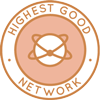 One Community is creating patterns of positive change through open source Highest Good Network® software that is a web-based application for collaboration, time tracking, and objective data collection. The purpose of the Highest Good Network is to provide software for internal operations and external cooperation. It is being designed for global use in support of the different countries and communities replicating the One Community sustainable village models and related components.
One Community is creating patterns of positive change through open source Highest Good Network® software that is a web-based application for collaboration, time tracking, and objective data collection. The purpose of the Highest Good Network is to provide software for internal operations and external cooperation. It is being designed for global use in support of the different countries and communities replicating the One Community sustainable village models and related components.
- Learn about our open source community collaboration and management software: The Highest Good Network
This week, the core team continued their work on the Highest Good Network PRs testing, confirming the fixed PRs and resolving several issues. They identified that the bug with deleted accounts is still showing in WBS tasks, labeled “Make delete function fully remove people,” and remains unresolved. They also logged 6 hours of tangible time for “CoreTeam TesterAgain” to test hours accumulation over 5 blue squares. This account already has 5 blue squares, and the missing summary report should generate the 6th blue square, adding 1 extra hour to the required hours for the core team. They referenced the bug report for “Core Team member’s additional hours should be processed properly.” Additionally, they reviewed pages 1-25 of the “Highest Good Network (HGN) User’s Manual,” updating images, providing comments, suggesting restructuring sections, and making necessary text updates. We continue to focus on creating patterns of positive change through iterative improvements and user-centric solutions. See the Highest Good Society and Highest Good Network pages for more on how this relates to creating patterns of positive change. The collage below shows some of their work.
ALPHA SOFTWARE DEVELOPMENT TEAM
The Alpha Team’s summary, covering their work on the Highest Good Network software software was managed by Lin Khant Htel (Frontend Software Developer) and includes (Software Engineer) Anand Seshadri, Carlos Gomez (Full-Stack Software Developer), Nanguan Lin (Software Developer), Rupa Rajesh Bhatia (Software Engineer), and Sheetal Mangate (Software Engineer). The Highest Good Network software is how we will manage and measure our processes for creating patterns of positive change across our social architecture, construction, production, and maintenance processes. This week, Lin reviewed and approved PR #2852, learning about the codebase and running all tests locally with successful results, and reviewed the weekly summaries, photos, and videos submitted by his Alpha team members. Anand focused on testing and reviewing multiple PRs, including PR 2831, where he confirmed fixes to text overflow and delete button alignment issues in dark and light modes; PR 2708, ensuring correct functionality in the Teams section with the assign team button tooltip at smaller resolutions and members modal display; PR 2855, which included improvements to the Project Report Pie Chart with a new toggle switch and selection options for individual or all members; and PR 2817, where a new button was added to filter and display paused tasks with updated filter logic, styling, and layout alignment, creating patterns of positive change that enhance team collaboration and project outcomes. Carlos collaborated with Jae on the team hours display report page, completing a feature that allows admin users to toggle between viewing individual, multiple, or combined member values, and further refined the UI by centering the toggle button and values around the foot chart. Jae approved the finalized work, and Carlos submitted PR F#2855; he also engaged in discussions with Howard Miao to assist on a time log submission task. Nanguan focused on fixing linting issues in the report component, spending approximately three hours on an incomplete refactor that encountered unresolved import path issues and function component naming errors. Rupa developed form page 6 in the HGN software, setting up navigation with React Router and integrating a responsive, reusable form component using Flexbox and media queries to ensure adaptability across screen sizes. She handled state management with React hooks, managing form validation and error handling for improved usability, and completed management training to align workflows with Lin’s guidance. Sheetal joined the development team, focusing on writing unit test cases, beginning with a study of the HGN Unit Testing Guide, where she gained insights into the significance of unit testing, creating test cases for a login form, and using the React Testing Library. Together, they are creating patterns of positive change by enhancing the software’s functionality, usability, and overall quality. She reviewed test cases submitted by other developers to learn best practices and continued learning how Redux integrates with React as part of her ongoing process. See the Highest Good Society and Highest Good Network pages for more on how this relates to creating patterns of positive change. View some of the team’s work in the collage below.
BINARY BRIGADE SOFTWARE DEVELOPMENT TEAM
The Binary Brigade Team’s summary overseeing advancements in the Highest Good Network software was managed by Vijay Anand Pandian (Full Stack Software Engineer) and includes Aaryaneil Nimbalkar (Software Developer), Anirudh Sampath Kumar (Software Developer), Ashish Nagaraju (Software Engineer), Ashmita Pandey (Software Engineer), Deepthi Kannan (Software Engineer), Geeta Matkar (Software Engineer), Huijie Liu (Software Engineer), Sai Venkatesh Voruganti (Volunteer Software Engineer), Sandhya Adavikolanu (Software Developer), Sriram Seelamneni (Software Engineer), Xiaolu Li (Software Engineer) and Ziyu Chu (Volunteer Software Engineer). The Highest Good Network software is how we’ll be managing and objectively measuring our process for creating patterns of positive change through our social architecture, construction, production, and maintenance processes.
This week, Aaryaneil completed reports on changes in PR 972, PR 1106, and PR 1105, highlighting their impact and implementation. He tested and reviewed several pull requests, including Ajay’s WBS title sort (#2849), Sharadha’s dropdown fix (#2848), lint fixes (#2847, #2846), and Rishitha’s team code updates (#2845). He also reviewed Nikita’s member list fix (#2854), Xiaolu’s unit test (#2852), and Gmon’s team page update (#2850). Backend testing covered Shreya’s core team hours fix (#1141), Ashish’s team report update (#1140), and Jatin’s backend form development (#1139). Anirudh reviewed and tested 11 pull requests: #2827, #2832, #2833, #2838, #2840, #2841, #2843, #2844, #2845, #2846, and #2847. His work involved assessing code quality, verifying the functionality of new and modified features, and ensuring compatibility with the project’s existing components. Anirudh identified issues affecting user experience and tested updates for consistency and performance in line with project standards. He also provided feedback to contributors to refine implementation details and address areas needing improvement, contributing to the application’s overall usability and stability. Through his contributions, Anirudh is consistently creating patterns of positive change, fostering improvements in both the technical and user experience aspects of the project.
Ashish started work on issue 24 related to the User Profile Component, a feature initially developed by another team member but reported to have ongoing problems by several users. He investigated the issue, aiming to replicate it in the development environment, but faced challenges reproducing it locally. Ashish proceeded to review the codebase to pinpoint possible causes of the problem. Ashmita focused on improving code quality within the `src/components/EmailSubscribeForm` directory of the HighestGoodNetworkApp. She used ESLint and other automated code formatting tools to address multiple linting errors and enhance the maintainability and consistency of the component files throughout the codebase. The files updated include `.eslintignore` and `src/components/EmailSubscribeForm/index.js`. Deepthi worked on resolving Git conflicts in PR 2838 to enable its merge into the development branch. She also created PR 2842 to address layout issues with earned dates on featured badges for screens below 1025px and worked on improving loading responsiveness related to this issue. Additionally, she focused on progressing several other open PRs, making necessary adjustments and refinements to prepare them for merging, creating patterns of positive change throughout the development process.
Geeta tested both the frontend and backend GitHub repositories to verify functionality across the codebase. She reviewed pull requests, including PR 2822, PR 2824, PR 2830, PR 2831, PR 2832, PR 2843, PR 2844, PR 2846, PR 2847, and PR 2849, focusing on feature checks and fixes. Her tasks included verifying search bar responsiveness, ensuring correct modal background display from the teams page, checking unit tests for user permissions, and confirming the rendering of pie charts, along with other updates aimed at validating integration and identifying potential issues. By performing these tasks, Geeta contributed to creating patterns of positive change, ensuring a seamless user experience and strengthening the overall codebase. Huijie focused on refining the bell notification functionality for the meeting scheduling feature, enhancing the logic for retrieving and displaying meeting information as notifications. She also implemented a “Mark as Read” feature to improve notification management. Additionally, she claimed a new task involving the development of a section within a form page. Sai resolved a React warning related to state updates on unmounted components, which can cause memory leaks if asynchronous tasks update the component state after its removal from the DOM. He identified the issue within an asynchronous function, `doSubmit`, which awaited a call to `this.props.loginUser` and could still attempt a `setState` call even after the component was unmounted. To address this, Sai introduced a flag named `_isMounted` to track the component’s mounting status, setting it to `true` in `componentDidMount` and to `false` in `componentWillUnmount`. He then modified `doSubmit` to use this flag, ensuring that state updates were only made when the component was still mounted, effectively preventing `setState` calls on unmounted components and reducing the risk of memory leaks. Sandhya enhanced the Total Organization Summary dashboard for the HGN Software Development project. She developed a Task Completed Bar Chart using Recharts, integrated it with Redux for state management, and ensured responsive design for various screen sizes. Sandhya also implemented backend data integration with actions like `getAllUsersTimeEntries`, added PDF export via jsPDF, and included the Web Share API for easy data sharing. In the broader TotalOrgSummary component, she created utility functions for time aggregation and added role-based access controls. Her testing focused on data accuracy, responsiveness, and functionality across different devices and browsers, creating patterns of positive change in the way the team approached development.
Sriram focused on reviewing and resolving merge conflicts in an older pull request to ensure it functions as expected within the codebase. He addressed feedback received on previous pull requests and fixed the raised issues. He then progressed on a new assigned task and evaluated code and implemented necessary changes then pushed the updated code with resolved conflicts. Vijay reviewed and contributed to several updates in the HGN Software Development project. He reviewed a PR that addressed an issue with saving featured badges in user profiles (PR #2825) and another that fixed a loading icon issue when adding new projects (PR #2804). He also reviewed a fix for a missing link in the WBSItem component that was causing reset issues (PR #2807). Additional reviews included a UI adjustment in the Teams Table (PR #2838), a fix for unnecessary page refresh when pressing Enter on the badge management page (PR #2830), and a PR introducing tests for the Teams component (PR #2788). Vijay also completed the unit testing implementation for the handleSuccessReducer file (PR #2844). Xiaolu completed the unit tests for the BlueSquaresTable/BlueSquareTable.jsx component, testing conditions for the editable toggle, dark mode, handleUserProfile, and handleBlueSquare. Xiaolu also submitted a PR titled “Xiaolu finish the unit test for BlueSquaresTable #2852.” Screenshots of the code and the weekly summary video were uploaded to the designated Dropbox folder for review. Ziyu began working on unit testing tasks, creating patterns of positive change within the team’s development process. She selected the task of writing unit tests for a component, TimeOffRequestsTable/ TimeOffRequestsTable.jsx, and chose five test cases to evaluate the component’s structure, functionality, and hooks. She wrote specific test code for each case; however, some tests did not pass during execution. See the Highest Good Society and Highest Good Network pages for more on how this relates to creating patterns of positive change. View some of the team’s work in the collage below.
BLUE STEEL SOFTWARE DEVELOPMENT TEAM
The Blue Steel Team’s summary, presenting their work on the Highest Good Network software was managed by Jingyi Jia (Software Engineer, Team Manager), and includes Cillian Ren (Software Engineer) and Ramakrishna Aruva (Software Engineer). The Highest Good Network software is how we’ll be managing and objectively measuring our process for creating patterns of positive change through our social architecture, construction, production, and maintenance processes. This week, Cillian tackled an issue in the Highest Good Network project where the deactivation date was not displaying correctly on the profile page. The “End Date” field was showing “Invalid date” when users clicked the button to deactivate an account. Cillian examined the code handling account status changes and reviewed various sections of the codebase to trace the root of the issue. He prepared adjustments to ensure the “End Date” field would display accurately upon resolving the problem. Meanwhile, Ramakrishna worked on identifying the necessary permissions for accessing the reports icon, utilizing an existing permissions method to retrieve and validate access rights to determine if the icon should be displayed. He developed a method that redirects to the designated user’s reports upon invocation and confirmed its functionality through testing. Additionally, Ramakrishna focused on creating patterns of positive change, selecting and placing appropriate icons from Font Awesome to meet project requirements. Jingyi focused on implementing and troubleshooting a modal designed to prompt users for confirmation when logging intangible time that they wish to convert to tangible. She refined the modal trigger to activate only when attempting to mark time as tangible, integrated three distinct response options into the modal, and styled each button to appear in a single row for a cleaner presentation. This work aimed to enhance usability and ensure compliance with time tracking processes. See the Highest Good Society and the Highest Good Network pages to learn more on how their work contributes to creating patterns of positive change. See below to view images of their work.
CODE CRAFTERS SOFTWARE DEVELOPMENT TEAM
The Code Crafters Team summary, covering their work on the Highest Good Network software, was managed by Akilan Kumaran (Software Engineer) and includes Dhrumil Dhimantkumar Shah (Software Engineer), Pavan Swaroop Lebakula (Software Engineer), Summit Kaushal (Backend Software Developer), Swaroop Udgaonkar (Software Engineer), Muzammil Moahmmed (Software Engineer) and Anoushka Gupta (Software Engineer). The Highest Good Network software is how we will manage and measure our processes for creating patterns of positive change across our social architecture, construction, production, and maintenance processes. This week, Swaroop focused on incorporating recent code updates and made adjustments to optimize the display of teams and projects on smaller screens, evaluating user-friendliness. In his role as a manager-in-training, he reviewed his team’s work, including images, videos, and summaries, and followed up with Denish and Muzammil on the team channel. Pavan worked on implementing bell icon functionality to retrieve data but faced technical limitations and sought assistance from Jae, using the waiting period to review pull requests. Summit met with the developer working on the Lead Team badge, addressed their questions, and created support videos. Summit reviewed the frontend code for the “volunteer time” section, analyzed tangible hours data, and explored merging data arrays to calculate maximum hours, identifying the need to adjust earned Dates for integrating tangible hours from Time Entries. Anoushka Gupta worked on fixing the “Most Hours in a Week” badge bug, using MongoDB and Postman, generating login and authorization tokens, adding logging statements, and updating the “checkMostHrsWeek” function logic to improve functionality, creating patterns of positive change in the process. Dhrumil focused on ensuring the “Export Featured” button remains disabled when no badges are featured, identified additional issues during the previous pull request, and worked with his manager to complete the necessary fixes. Muzammil addressed issue 104 related to category inconsistencies in the ‘create project’ feature under the Profile > Projects tab, traced the root cause through past pull requests, and is nearing completion of the fix. This work helps One Community’s mission of creating patterns of positive change. The collage below shows the work for this week.
DEV DYNASTY SOFTWARE DEVELOPMENT TEAM
The Dev Dynasty Team’s summary, covering their work on the Highest Good Network software, was managed by Yash Shah (Data Analyst and Team Administrator) and includes Harsh Bodgal (Software Engineer), Ajay Kumar Reddy (Software Engineer), Crystal Low (Software Engineer), Lucy Xi (Software Engineer), Jatin Agrawal (Software Engineer), Manikrishna Sanganabatla (Software Engineer), Mrinalini Raghavendran (Software Engineer), Nandini Yelmela (Software Engineer), Sailavanya Narthu (Software Engineer), Shreya Vithala (Software Engineer), Nikita Kolla (Full Stack Developer), Nishita Gudiniye (Software Engineer) and Varun Elangovan (Software Engineer). The Highest Good Network software is how we’ll manage and objectively measure our process for creating patterns of positive change through our social architecture, construction, production, and maintenance processes. This Week, Ajay focused on enhancing the Work Breakdown Structure (WBS) and Project pages by improving both the user interface and functionality. His updates included centering titles, refining sorting options, and applying formatting changes for consistency across related pages. He also updated components and test files to incorporate these improvements. Fangle concentrated on backend development for Instagram posting APIs, specifically writing and testing code for image posting. She joined discussions about task APIs and will continue refining features like post scheduling in the weeks to come. Jatin made progress on resolving an invisible toggle permission bug, addressing this issue through a pull request. He responded to review feedback and updated test cases to ensure they aligned with the updated functionality. Manikrishna focused on reviewing many pull requests, ranging from PRs #2832 to #2849, while also searching for additional bugs in the application. In addition, he completed a bio for publication and held a feature discussion call with his manager, creating patterns of positive change through his work in reviewing and refining key processes. Mrinalini resolved a critical timelog issue within the Timelog.jsx component, updated the Application Page design document based on feedback, and began work on a new task from the bugs and functionalities document. She confirmed that the timelog fix worked across scenarios and submitted a pull request with the changes. Nandini addressed various issues in the HGN Software Development project, including an error with the react-collapsible module and a TypeError in the breadcrumbs.ts file. She worked to handle undefined props in multiple components and tested changes across both dark and light modes to ensure stability. Nikita raised pull requests for the “input components for Google Form replacement” and “fix incomplete members list when all-time is selected” tasks. She also began working on fixing a Badge Categories count and assignment issue, studying the badge codebase to identify relevant problem areas. Nishita focused on the Team Stats – Comparison Needed component, analyzing metrics related to team dynamics and reviewing requirements to ensure accurate data representation. Sailavanya worked on resolving issues in the sailavanya_fix_blank_page_issue_fresh branch, tackling validation problems, state update warnings, and nesting errors. She also fixed a bug that caused a blank page when selecting badges in the User Profile and updated dependencies to ensure smooth functionality. In all these tasks, the team was focused on creating patterns of positive change, ensuring a smooth and consistent user experience across the project. Shreya worked on enhancing the responsiveness of the header image and text on smaller screens and began addressing an issue where new users were not visible in the User Management section after a page refresh. She analyzed the relevant code files and documented her findings for future improvements. Lastly, Varun transitioned to the development team “devdynasty.” He completed his onboarding process, held discussions with his manager regarding upcoming tasks, familiarized himself with the team’s codebase, and started validating pull requests related to the backend implementation of the Total Org Summary feature. Together, they are creating patterns of positive change, driving progress and ensuring stability in the project. See the Highest Good Society and Highest Good Network pages for more on how this relates to creating patterns of positive change. View some of the team’s work in the collage below.
EXPRESSERS SOFTWARE DEVELOPMENT TEAM
The Expressers Team’s summary, covering their work on the Highest Good Network software, was managed by Christy Guo (Software Engineer) and includes Aishwarya Ramesh (Software Engineer), Haoqing Zhu (Software Engineer), Howie Miao (Software Engineer), Rahul Trivedi (Software Developer), Reina Takahara (Software Developer), and Strallia Chao (Software Engineer). The Highest Good Network software is how we’ll manage and objectively measure our process for creating patterns of positive change through our social architecture, construction, production, and maintenance processes. This week, Aishwarya implemented the trophy icon display for anniversaries on the weekly report summaries page, handling both frontend and backend components. Christy focused on unit testing and data visualization, including testing multiple pull requests and contributing to the development of a Project Task Chart using D3.js within the ProjectTask component. Haoqing, recently promoted to developer, reviewed a total of 10 pull requests, requesting changes on four and approving six, while also fixing a bug related to People Report formatting. Howie addressed several hotfixes, such as adjustments to the teams scrollbar for better accessibility, adding a double confirmation step for task submissions, and reviewing a system date bug for future resolution. Rahul developed the initial page of the HGN Form for Developers. Reina worked on integrating backend and frontend updates, completing a feature to retrieve, add, and delete tag information. Strallia continued building backend logic for the Hours Completed chart on the Total Org Summary page, focusing on refining calculations. See the Highest Good Society and Highest Good Network pages for more on how this relates to creating patterns of positive change. See the collage below to view the team’s work this week.
LUCKY STAR SOFTWARE DEVELOPMENT TEAM
The Lucky Star Team’s summary, covering their work on the Highest Good Network software, was managed by Anne Zhang (Software Engineer) and includes contributions from Chetan Sunku (Software Engineer), Koushica Bosadi Ulaganathan (Software Engineer), Nikhitha Kalinga (Software Engineer), T R Samarth Urs (Data Analyst) ,Vaibhavi Madhav Deshpande (Software Engineer), and Ziyan Wang (Software Engineer). The Highest Good Network software is how we will manage and measure our processes for creating patterns of positive change across our social architecture, construction, production, and maintenance processes. This week, Chetan continued work on the dashboard time update issue, focusing on how logged time is displayed without requiring a page reload. Koushica reviewed multiple pull requests for the HighestGoodNetworkApp, approving PR #2823 and assessing PR #2760’s responsiveness updates, with improvements expected in a forthcoming PR. She also began a new task, creating a branch for displaying a Google Docs symbol, analyzing code, and implementing initial changes. Nikhitha did her part creating patterns of positive change as she focused on addressing user permission bugs related to toggling active and inactive statuses on the Profile and User Management pages, implementing changes in Permissions Management, resolving conflicts, and testing updates. Samarth managed a PR review team, assessing review quality, providing feedback on each document, and summarizing the team’s work in a blog post, which he submitted along with a collage of team images. Vaibhavi reviewed the HGN Phase III: Social Architecture Tracking and Management System Outline, studying its functionalities and user roles within the Highest Good Network framework and drafting related subtasks. Ziyan completed the “146 Optimize the app for Safari” task, reviewing console and compatibility issues to ensure app functionality across the Dashboard, Profile, Task, Password, and Location sections in both light and dark modes on Safari. Relevant images were uploaded to the Week 6 Dropbox folder. Anne addressed the member column filter bug in the ProjectTableHeader and Projects files, verifying the function for fetching backend data on active members. She also resolved merge conflicts from previous PRs, managed her team’s tasks, and reviewed team photos and videos for the weekly summaries. Through these efforts, the team is collectively creating patterns of positive change in the Highest Good Network, contributing to its ongoing growth and impact. Learn more about how the Highest Good Society and Highest Good Network will measure and assist in creating patterns of positive change in the Highest Good Network open source hub, See their work on the collage below.
MOONFALL SOFTWARE DEVELOPMENT TEAM
The Moonfall Team’s summary, covering their work on the Highest Good Network software was managed by Satya Shanthi Tadiparthi (Team Manager), and includes Bhavya Prakash (Software Engineer), Calvin Liu (PR Team), Newell Newell (PR Team I-N), Nikhil Giri (Software Engineer), Rachana Zha (Software Engineer), Rishabh Nevatia (Software Engineer), Saurabh Shetty (Software Engineer), Shashank Kumar (Software Engineer), Swathi Dharma Sankaran (Software Engineer), Vedant Gandhi (Software Engineer), and Yili Sun (Software Engineer). The Highest Good Network software is how we will manage and measure our processes for creating patterns of positive change across our social architecture, construction, production, and maintenance processes. This week, Bhavya has collaborated with Summit to reproduce a bug and gain access to MongoDB, initiating debugging efforts by testing APIs in Postman. Creating patterns of positive change, she has verified responses to identify the root cause, which was eventually traced to a data retrieval limit issue in MongoDB; additional assistance was sought via Slack to troubleshoot. Calvin has focused on resolving Bug 16, which involved implementing a scrollable table in the inventory type list to limit the page’s height, while enhancing visual elements with alternating row colors, hover effects, padding, borders, and shadowing for improved usability. By creating patterns of positive change, Newell has optimized a community website’s database and achieved a loading time of 0.8 seconds. He has created a mockup for a new HGN app design, along with setting up monitoring tools. Nikil has completed reviews and tested several PRs. He has focused on responsiveness, UI consistency, and functionality. He has validated updates in PRs like 2838 for teams table responsiveness, 2840 for project name display, and 2843 for time log reloading, while ensuring all unit tests and dropdown visibility checks passed successfully. Rachana has delved into gzip compression research for Express.js and studied documentation and real-world applications to understand configuration settings. She has measured its impact on response size using tools like Postman, Chrome DevTools, and Google Lighthouse, while examining compatibility and CPU concerns for high-traffic servers. Rishabh has worked on advancing the material purchase approval feature and collaborated with a teammate to clarify requirements. He has refined frontend updates. Satya has reviewed and tested multiple PRs and included verifying unit tests for AddTeamsAutoComplete in PR 1914. She has addressed an issue with the TotalOrgSummary bar chart in PR 2713 and validated display changes in PR 2848. By taking ownership of these tasks, she is creating patterns of positive change. She has approved PRs related to Teams Modal UI and handleSuccessReducer; she also compiled a final proofread summary from team submissions. Shashank has completed Page 3 components based on Figma designs. Swathi has focused on PR 2789 and conducted tests on rendering, functionality, useEffect hooks, and edge cases. Also, she has implemented a hotfix to reduce a component jump during rendering. Vedant has resolved merge conflicts for PRs 2687 and 2708. He has modified PR 2821 for responsive summary sections and clarified task requirements with a teammate. Yili has addressed permissions and UI stability issues. She has fixed a popup error on the Profile page. She has removed unused functions, and improved layout consistency on the User Management page for various screen sizes. See the Highest Good Society and Highest Good Network pages for more on how this relates to creating patterns of positive change. Below is a collage for the team’s work:
REACTONAUTS SOFTWARE DEVELOPMENT TEAM
The Reactonauts Team’s summary, covering their work on the Highest Good Network software, was managed by Vijeth Venkatesha (Software Engineer). It included Dhairya Mehta (Software Engineer), Gmon Kuzhiyanikkal (Software Engineer), Haoyue Wen (Software Engineer), Jinxiong You (Software Developer), Khushi Jain (Software Engineer), Mohan Gadde (Software Engineer), Nikhil Pittala (Software Engineer), Pallavi Thorat (Software Engineer), Peterson Rodrigues dos Santos (Full-Stack MERN Stack Developer), Rishitha Mamidala (Software Engineer), Saniya Farheen (Software Engineer) and Sharadha Shivakumar(Software Engineer). The Highest Good Network software is creating patterns of positive change across social architecture, construction, production, and maintenance processes. This week, the team made significant progress across multiple tasks. Dhairya addressed an issue with the user function in projects, improving the user discovery experience with an optimized sort and search function. Gmon completed his task of adding active/inactive team numbers, submitting PR 2850, and prepared screenshots and videos for review. Haoyue tackled merge conflicts, refined multiple pull requests, and began work on an FAQ feature. Jinxiong identified and fixed bugs in the HGN app, including a critical freezing issue, while reviewing several PRs. Khushi developed the “New Position Setup Page” mockup and started work on an auto-poster for Medium. Mohan worked on troubleshooting the project archive functionality, where he found and documented a freezing issue. Nikhil completed 12 pull request reviews, contributing to code quality and stability. Pallavi improved the User Management search function and fixed a dark mode display bug. Peterson enhanced search functionality on the User Management page, enabling full-name searches. Rishitha simplified user creation by removing the team code requirement and investigated a filtering issue on the project page. Saniya resolved a visibility bug on team member profiles and is investigating a dashboard issue. Sharadha fixed a dropdown issue with the Review button and began addressing a screen freeze in the Team Member Tasks section. Vijeth focused on bug hunting for Phases 1 and 2, supported team queries, and managed the team through meetings, updates, and submission oversight. his momentum showcases how the team’s efforts are creating patterns of positive change, driving innovation and cohesion across projects. See the Highest Good Society and the Highest Good Network pages to learn more on how their work contributes to creating patterns of positive change. See below to view images of their work.
SKYE SOFTWARE DEVELOPMENT TEAM
This week Skye Team’s summary covering their work on the Highest Good Network software was managed by Rishabh Rao (Administrator) and Luis Arevalo (Software Engineer) and the team includes Abi Liu (Software Developer), Laura Cohen (Software Engineer), Sai Preetham (Full Stack Developer), Yao Wang (Software Engineer), and Zhimin Liang (Full Stack Developer). The Highest Good Network software supports creating patterns of positive change social architecture, construction, production, and maintenance processes. This week, Abi focused on refactoring the volunteer trends query, encountering unforeseen challenges that required extensive time exploring various query methods to improve data retrieval accuracy. He reviewed documentation in detail and debugged complex queries to meet project requirements, demonstrating creating patterns of positive change in his approach to problem-solving. Laura configured logic for the permission change modal to appear only for users with custom permissions and adjusted it to display correctly in dark mode. She also reviewed front-end code across the application to maintain UI consistency and locate supporting functions and utilities for the modal’s appearance. Yao continued working on backend API issues related to LinkedIn company posts, specifically addressing persistent 401 errors likely due to restrictions on the testing account. Yao reached out to LinkedIn for assistance, as login issues may contribute to these errors, and encountered LinkedIn service error code 65608, which may also relate to the restriction. Snehal completed modifications for a bug regarding project member deletion, updating members.jsx and member.jsx files and creating a branch named “Snehal_delete_0members_from_project” for these changes. She reviewed PR2673 to verify updates for archiving projects and setting them to inactive and planned to create a pull request for the bug fixes by Saturday. Through creating patterns of positive change, Snehal and the team are reinforcing structured problem-solving and collaboration. Zhimin explored different YouTube API methods, such as “Search” and “Channel,” and tested them using Postman. She started the initial backend code on her local computer, installed the necessary packages, created a file to initialize the YouTube API client, and defined a schema to store scheduled YouTube posts and planned to create a POST function and, if time allowed, set up routes and controller functions. Sai Preetham worked on resolving the “Name Overflow on Dashboard” issue within the HGN Software Development project by identifying the cause of the overflow affecting long names. He created a branch named “Sai_Preetham_Name_Overflow_On_Dashboard” and modified the JSX structure with partial CSS updates to improve styling, which helped mitigate some display issues, though additional work remains. See the Highest Good Society and the Highest Good Network pages to learn more on how their work contributes to creating patterns of positive change. He also completed weekly summary and Dropbox tasks related to this issue, documenting his progress and observations. See below for the work done by the group.
SOFTWARE PR REVIEW TEAM A-K
The PR Review Team’s summaries for team members’ names starting with A-K and covering their work on the Highest Good Network software was managed by Anoushka Hazari (Data Analyst). The Highest Good Network software is a foundation of what we’ll be using to measure our results for creating patterns of positive change. This week’s active members of this team were: Abdelmounaim Lallouache (Software Developer), Anjineyulu Annavarapu (Software Developer), Ajit Patil (Software Engineer), Ashrita Cherlapally (Software Engineer), Audrey Trinh (Software Engineer Intern), Carl Bebli (Software Engineer), Humera Naaz (Mern Developer), and Kurtis Ivey (Full Stack Developer). They reviewed all the Highest Good Network PRs (Pull Requests) shared in this week’s update. Learn more about how the Highest Good Network will measure and assist in creating patterns of positive change in the Highest Good Network open source hub. The collage below shows a compilation of the work from this team.
SOFTWARE PR REVIEW TEAM L-Sg
The PR Review Team’s summary for team members’ names starting with L-Sg and covering their work on the Highest Good Network software was managed by Saumit Chinchkhandi (Administrative Assistant and Software Engineer). The Highest Good Network software is a foundation of what we’ll be using to measure our results of creating patterns of positive change. This week’s active members of this team were: Muhideen Mustapha (Software Engineer), Nahiyan Ahmed (Full Stack Software Developer), Nathan Hoffman (Software Engineer), Rashmitha Kalliot Yadav (Software Engineer), and Rui Liu (Software Engineer). They reviewed all the Highest Good Network PRs (Pull Requests) shared in this week’s update. Learn more about how the Highest Good Network measures and assists in creating patterns of positive change in the Highest Good Network open source hub. The collage below shows a compilation of the work from this team.
SOFTWARE PR REVIEW TEAM Sh-Z
The PR Review Team’s summary for team members’ names starting with Sh-Z and covering their work on the Highest Good Network software was managed by Olawunmi “Ola” Ijisesan (Administrative and Management Support) and Samarth Urs (Administrative Assistant and Data Analyst). The Highest Good Network software is a foundation of what we’ll be using to measure our results of creating patterns of positive change. This week’s active members of this team were: Supriya Sudini (MERN Stack Developer), Neeharika Koniki (Software Engineer, Developer), and Yiyun Tan (Software Engineer). They reviewed all the Highest Good Network PRs (Pull Requests) shared in this week’s update. Learn more about how the Highest Good Network will measure and assist in creating patterns of positive change in the Highest Good Network open source hub. The collage below shows a compilation of the work from this team.
AND WE PRODUCED THIS WEEKLY UPDATES BLOG – CLICK HERE TO SUBSCRIBE
FOLLOW ONE COMMUNITY’S PROGRESS (click icons for our pages)
INVESTOR PAGES
GET INVOLVED
DONATE | WAYS ANYONE CAN HELP | MEMBERSHIP
CLICK HERE FOR ALL PAST UPDATES
 One Community
One Community

